Contents
- 1 SyllabusからOUTCOMES要約
- 2 自作問題(教科書Ch26)
- 2.1 Question 1:腎臓の主な機能
- 2.2 Question 2:腎臓Na排出
- 2.3 Question 3:腎臓の酸排出
- 2.4 Question 4:Erythropoietin
- 2.5 Question 5:機能単位
- 2.6 Question 6:Calcitriol
- 2.7 Question 7:糖新生
- 2.8 Question 8:Creatinine
- 2.9 Question 9:非揮発性酸の排出
- 2.10 Question 10:排尿反射
- 2.11 Question 11:外括約筋
- 2.12 Question 12:Detrusor muscle
- 2.13 Question 13:尿管腎反射
- 2.14 Question 14:三角部
- 2.15 Question 15:排尿波
- 2.16 Question 16:溢流性失禁
- 2.17 Question 17:GFRの機能
- 2.18 Question 18:グルコースの濾過
- 2.19 Question 19:脊髄損傷と排尿
- 2.20 Question 20:尿管の蠕動運動
- 2.21 Question 21:無抑制性神経原性膀胱
- 2.22 Question 22:カリウムイオン濃度
- 2.23 Question 23:弛緩膀胱
- 2.24 Question 24:アルドステロン
- 2.25 Question 25:ADH
- 2.26 Question 26:PTH
- 2.27 Question 27:血漿浸透圧
- 3 自作(教科書Ch27)
- 3.1 Question 1:GFR決定因子
- 3.2 Question 2:糸球体毛細血管膜
- 3.3 Question 3:糸球体毛細血管膜の電荷
- 3.4 Question 4:糸球体内静水圧
- 3.5 Question 5:Podocytes
- 3.6 Question 6:尿路の閉塞
- 3.7 Question 7:糸球体毛細血管の表面積
- 3.8 Question 8:輸出細動脈
- 3.9 Question 9:糸球体濾過(Na)
- 3.10 Question 10:濾過分画
- 3.11 Question 11:フィルタレーションフラクション
- 3.12 Question 12:デキストラン
- 3.13 Question 13:腎血流量
- 3.14 Question 14:腎血管抵抗
- 3.15 Question 15:髄質の血流
- 3.16 Question 16:Norepinephrine
- 3.17 Question 17:自己調整機能
- 3.18 Question 18:腎臓の酸素消費
- 3.19 Question 19:Angiotensin II
- 3.20 Question 20:高タンパク質食
- 3.21 Question 21:血管直(vasa recta)
- 3.22 Question 22:Tubuloglomerular feedback
- 3.23 Question 23:GFRと年齢
- 3.24 Question 24:Endothelin
- 3.25 Question 25:圧利尿(pressure diuresis)
- 3.26 Question 26:Aldosterone
- 3.27 Question 27:GFRと性別
- 3.28 Question 28:myogenic mechanism
- 3.29 Question 29:圧排尿(pressure natriuresis)
- 3.30 Question 30:GFRと酸化ストレス
- 3.31 Question 31:Prostaglandin
- 3.32 Question 32:一酸化窒素
- 4 過去問1
- 4.1 Question 1:間質液浮腫
- 4.2 Question 2:輸入細動脈と糸球体
- 4.3 Question 3:Renin
- 4.4 Question 4:女性の平均体水分量
- 4.5 Question 5:細胞内液の主要な陽イオン
- 4.6 Question 6:エバンスブルー染料
- 4.7 Question 7:浸透と濃度勾配
- 4.8 Question 8:細胞内液
- 4.9 Question 9:ドナン効果
- 4.10 Question 10:等張液と赤血球
- 4.11 Question 11:低ナトリウム血症
- 4.12 Question 12:尿崩症
- 4.13 Question 13:細胞外浮腫
- 4.14 Question 14:毛細血管内膠質浸透圧
- 4.15 Question 15:細胞内陽イオン
- 4.16 Question 16:Renin
- 4.17 Question 17:Vitamin D₃
- 4.18 Question 18:機能単位
- 4.19 Question 19:輸出細動脈
- 4.20 Question 20:Peritubular capillaries
- 4.21 Question 21:遠位尿細管
- 4.22 Question 22:傍糸球体装置
- 4.23 Question 23:ネフロン(皮質&髄質)
- 4.24 Question 24:デトルサー筋と排尿反射
- 4.25 Question 25:デトルサー筋と副交感神経
- 4.26 Question 26:外尿道括約筋と体性神経
- 4.27 Question 27:膀胱尿管逆流
- 4.28 Question 28:ストレス尿失禁
- 5 過去問2
- 5.1 Question 1:GFRの計算
- 5.2 Question 2:インスリンと近位尿細管
- 5.3 Question 3:デトルサー筋
- 5.4 Question 4:腎血漿流量の測定に使用される典型的な物質
- 5.5 Question 5:近位尿細管のリン酸再吸収
- 5.6 Question 6:イヌリン
- 5.7 Question 7:尿管腎反射
- 5.8 Question 8:カリウムの排出
- 5.9 Question 9:近位尿細管での尿素と水の再吸収
- 5.10 Question 10:管糸球体フィードバック
- 5.11 Question 11:近位尿細管でのアミノ酸の再吸収
- 5.12 Question 12:ヘンレループでのマグネシウムの再吸収
- 5.13 Question 13:高カリウム血症
- 5.14 Question 14:腎動脈への圧力とレニン分泌
- 5.15 Question 15:Na⁺-K⁺ポンプ
- 5.16 Question 16:近位尿細管と水分再吸収率
- 5.17 Question 17:傍髄質(Juxtamedullary)
- 5.18 Question 18:うっ血性心不全や循環血液量への腎血流の反応
- 5.19 Question 19:チアジド感受性ナトリウム-塩素共輸送体(NCCT)
- 5.20 Question 20:Podocytes
- 5.21 Question 21:デトルサー筋
- 5.22 Question 22:糸球体毛細血管と静水圧
- 5.23 Question 23:対向流増幅機構
- 5.24 Question 24:Norepinephrine
- 5.25 Question 25:ビタミンD3
- 5.26 Question 26:aldosterone
- 5.27 Question 27:近位尿細管でのH⁺の輸送
- 5.28 Question 28:血漿浸透圧
- 5.29 Question 29:低カリウム食と近位尿細管
- 5.30 Question 30:細胞外液の浸透圧
- 5.31 Question 31:デトルサー筋とアセチルコリン
- 5.32 Question 32:グルコースの排出率
- 5.33 Question 33:副甲状腺ホルモン(PTH)
- 5.34 Question 34:アルドステロン
- 5.35 Question 35:レニン
- 5.36 Question 36:アンジオテンシンII
- 5.37 Question 37:対向流増幅機構
- 5.38 Question 38:PTH
- 5.39 Question 39:遠位ネフロン
- 5.40 Question 40:エリスロポエチン(EPO)
- 5.41 Question 41:アルドステロン拮抗薬
- 5.42 Question 42:GFR
- 5.43 Question 43:Vasopressin
- 5.44 Question 43:腎性尿崩症
- 5.45 Question 45:β-アドレナリン受容体刺激
- 5.46 Question 46:糸球体毛細血管の濾過係数
- 5.47 Question 47:腎臓結石
SyllabusからOUTCOMES要約
Module No. 15: Fluid and Renal Physiology
- 細胞内液と細胞外液の異なるイオン成分を特定する
- 細胞内液(Intracellular Fluid, ICF): 主にカリウムイオン(K⁺)とリン酸イオン(PO₄³⁻)が多く含まれます。
- 細胞外液(Extracellular Fluid, ECF): ナトリウムイオン(Na⁺)とクロールイオン(Cl⁻)が豊富で、血漿や間質液(Interstitial Fluid)を含みます。
- 細胞外液の浸透圧の増減が細胞内外の移動に与える影響を対比する
- **浸透圧(Osmolality)**が増加すると、細胞外へ水が移動し、細胞が縮む可能性があります(脱水の状態)。
- 浸透圧が減少すると、細胞内へ水が移動し、細胞が膨らむ可能性があります(過水和の状態)。
- 高張液、等張液、低張液の定義と細胞間の液交換の変化を予測する
- 高張液(Hypertonic Solution): 細胞外の浸透圧が細胞内よりも高く、細胞から水が出て縮む。
- 等張液(Isotonic Solution): 細胞内外の浸透圧が等しいため、水の移動がほぼありません。
- 低張液(Hypotonic Solution): 細胞外の浸透圧が細胞内よりも低く、細胞内に水が入り、細胞が膨張します。
- 水の摂取と喪失の主な経路と通常範囲を特定する
- 摂取: 飲料水、食物、代謝水が主要な水の摂取源です。
- 喪失: 汗、尿、呼気、および便からの水の喪失があります。正常範囲は個人によって異なりますが、1日に約2リットル程度です。
- 指標希釈法(Indicator Dilution Principle)の利用を示す
- 指標希釈法は、体液量や特定の体内成分の濃度を測定するために使用される方法で、例えば血漿量を測定する際に使用されます。
- 低ナトリウム血症(Hyponatremia)と高ナトリウム血症(Hypernatremia)の影響を特定し、その状態を引き起こす疾患を挙げる
- 低ナトリウム血症: 過剰な水分保持またはナトリウム喪失によって引き起こされ、神経機能の低下を引き起こすことがあります。
- 高ナトリウム血症: 脱水などによるナトリウム過剰で、意識障害や昏睡を引き起こすことがあります。腎不全や糖尿病が一因となることもあります。
- 浮腫の2つのタイプを区別し、そのa) 原因、b) 形成を促進する要因、c) それを防ぐ安全因子を特定する
- 局所浮腫(Localized Edema): 特定の部位に限定され、炎症や外傷が原因となることが多いです。
- 全身浮腫(Generalized Edema): 全身にわたる浮腫で、心不全や腎不全が原因となることが一般的です。
- 形成を促進する要因: 血管透過性の増加や静脈圧の上昇が挙げられます。
- 安全因子: リンパ管の排出機能や浸透圧の調整が浮腫の発生を防ぎます。
- 「潜在的空間」における液体の蓄積を定義する
- 潜在的空間(Potential Spaces): 胸腔や腹腔のように通常は液体がほとんどない空間ですが、病的な状態で液体が蓄積することがあります(例:腹水)。
- 腎臓の構造と腎臓の機能単位を特定し、腎臓の異なる生理的機能を説明する
- 腎単位(Nephron): 腎臓の機能単位であり、濾過、再吸収、分泌によって尿を生成します。腎臓は血液の浄化や酸塩基バランスの維持などを行います。
- 超濾液が通過する管状セグメントの順序を説明する
- 腎小体で生成された超濾液は、近位尿細管(Proximal Tubule)、ヘンレのループ(Loop of Henle)、遠位尿細管(Distal Tubule)、および**集合管(Collecting Duct)**を順に通過します。
- 排尿(Micturition)と排尿反射(Micturition Reflex)の過程を説明する
- 排尿反射: 膀胱が満杯になると神経が刺激され、膀胱収縮が引き起こされて尿が排出される反射です。通常は意識的に制御されます。
- 尿生成の結果となる腎臓の過程を説明する
- 濾過(Filtration)、再吸収(Reabsorption)、**分泌(Secretion)**という3つの主要な過程によって尿が生成され、血液中の老廃物が体外へ排出されます。
Module No. 16: Renal Physiology – Glomerular Filtration and Tubular Function
- 糸球体濾過障壁を構成する3層を説明し、ポドサイト(Podocytes)、足突起(Foot Processes)、スリット(Filtration Slits)、基底膜(Basement Membrane)を特定する
- **糸球体濾過障壁(Glomerular Filtration Barrier)**は、次の3層で構成されます:
- 内皮細胞層(Endothelial Cell Layer): 小さな孔があり、分子の選択的な通過を制御します。
- 基底膜(Basement Membrane): 糸球体濾過の主要な障壁で、陰電荷を持ち、負に帯電した分子を排除します。
- ポドサイト層(Podocyte Layer): ポドサイトは糸球体の外側に位置し、足突起とフィルタースリットを形成して濾過を制御します。
- **糸球体濾過障壁(Glomerular Filtration Barrier)**は、次の3層で構成されます:
- 腎血流(Renal Blood Flow)、腎血漿流量(Renal Plasma Flow)、糸球体濾過率(GFR)、および濾過分画(Filtration Fraction)を定義する
- 腎血流(RBF): 腎臓に供給される全血流量。
- 腎血漿流量(RPF): 血漿の流量で、血液から赤血球成分を除いた流量です。
- 糸球体濾過率(GFR): 一定時間あたりに糸球体で濾過される液体量。
- 濾過分画(Filtration Fraction): GFRをRPFで割った値で、濾過される血漿の割合を示します。
- 糸球体毛細血管での正味濾過力を計算し、各圧力の増減による糸球体濾過への変化を予測する
- **正味濾過力(Net Filtration Force)**は、毛細血管静水圧、膠質浸透圧、およびボーマン嚢静水圧のバランスに依存します。各圧力の変化は、濾過速度(GFR)に直接影響を与えます。
- 輸入細動脈と輸出細動脈の相対的な抵抗および腎血流およびGFRへの影響を説明する
- **輸入細動脈(Afferent Arteriole)と輸出細動脈(Efferent Arteriole)**の抵抗変化により、腎血流およびGFRが調整されます。輸入細動脈の収縮はGFRを減少させ、輸出細動脈の収縮はGFRを増加させる傾向があります。
- 腎血漿流量とGFRの自己調節を仲介する筋原性および糸球体管フィードバック機構を説明する
- 筋原性機構(Myogenic Mechanism): 血圧の変動に応じて血管平滑筋が収縮または弛緩し、腎血流が調整されます。
- 糸球体管フィードバック(Tubuloglomerular Feedback): 糸球体傍細胞装置がGFRを調整し、過度な濾過を防ぎます。
- 腎血流および糸球体濾過に対する以下の要因の変化を予測する
- アンジオテンシンIIの増加: 輸出細動脈の収縮を引き起こし、GFRを維持または増加させます。
- 心房性ナトリウム利尿ペプチドの増加: 血管を拡張し、腎血流およびGFRを増加させます。
- プロスタグランジンの増加: 輸入細動脈を拡張し、腎血流を増加させます。
- 一酸化窒素の増加: 血管拡張作用により、腎血流を増加させます。
- 近位尿細管上皮を介した移動の経細胞経路と細胞間経路を対比する
- 経細胞経路(Transcellular Pathway): 物質が細胞を通過する経路で、選択的な吸収と分泌が行われます。
- 細胞間経路(Paracellular Pathway): 細胞間隙を通過する経路で、浸透圧や濃度勾配による受動的な移動が行われます。
- 主なネフロンセグメントが溶質および水の濾過負荷の再吸収に与える寄与を説明する
- 近位尿細管は多くの溶質と水を再吸収し、ヘンレのループや遠位尿細管も重要な役割を果たしています。
- 主要な管状セグメントによるNa⁺、Cl⁻、K⁺、HCO₃⁻、Ca²⁺、リン酸、糖、有機溶質(アミノ酸、尿素など)、および水の輸送に関する細胞機構を説明する
- 各イオンや分子は特定のトランスポーターやチャネルを介して再吸収または分泌され、濃度勾配やATPを利用して移動します。
- 以下の腎トランスポーターの機能と、それらのネフロンセグメントおよび管腔側膜と基底側膜における優勢な局在化を説明する
- 輸送ATPアーゼ(Transport ATPases): Na⁺/K⁺ ATPアーゼなどで、濃度勾配の維持に重要。
- イオンおよび水チャネル(Ion and Water Channels): Na⁺チャネルやアクアポリン(AQP)など、各セグメントでの再吸収に役立ちます。
- 共役輸送体(Coupled Transporters): Na⁺-グルコース共輸送体など、濃度勾配を利用した物質の輸送を行います。
- K⁺、Ca²⁺、リン酸、マグネシウムの再吸収および分泌の管状部位を特定する
- 近位尿細管、ヘンレのループ、および集合管がこれらのイオンの再吸収と分泌の主な部位となります。
- 集合管でのK⁺分泌を調節する要因を説明し、K⁺分泌に影響を与える要因との違いを区別する
- アルドステロンや流速の変化がK⁺分泌に影響を与えます。異なるホルモンやイオンの濃度も調整因子として関与します。
- PTH、カルシトニン、1,25-ジヒドロキシビタミンD(カルシトリオール)によるCa²⁺およびリン酸輸送の腎調節と、他の因子による調節との違いを説明する
- 副甲状腺ホルモン(PTH): Ca²⁺再吸収を促進し、リン酸の排泄を増加させます。
- カルシトニン(Calcitonin): Ca²⁺再吸収を抑制します。
- カルシトリオール(1,25-Dihydroxy Vitamin D): Ca²⁺およびリン酸の吸収を促進します。他のホルモンや栄養状態もこれらの輸送に影響します。
自作問題(教科書Ch26)
Question 1:腎臓の主な機能
問題文: What is the primary function of the kidneys in maintaining homeostasis?
- a. Filtration of plasma and removal of wastes
- b. Production of digestive enzymes
- c. Storage of bile
- d. Regulation of lymphatic flow
Answer: a. Filtration of plasma and removal of wastes
解説:
腎臓の主な機能は、血漿をろ過し、不要な物質を尿として排出することで、体内の恒常性を維持することです。この過程により、代謝により生成される老廃物や毒素が体外に排出されます。他の選択肢は腎臓の機能ではありません。
- b. 消化酵素の生成は主に膵臓などの消化器系の臓器によって行われます。
- c. 胆汁の貯蔵は胆嚢の役割であり、腎臓には関係ありません。
- d. リンパ液の流れの調整はリンパ系の役割であり、腎臓の機能には含まれません。
Question 2:腎臓Na排出
問題文: Which of the following ions does the kidney play a crucial role in regulating to maintain blood pressure?
- a. Calcium
- b. Potassium
- c. Sodium
- d. Chloride
Answer: c. Sodium
解説:
腎臓はナトリウムの排出量を調節することで、血圧の長期的な調整に関与しています。ナトリウムの量が変動すると、血液量が変化し、それが血圧に影響を与えます。他の選択肢も腎臓により調整されますが、血圧の主要な調整因子ではありません。
- a. カルシウムは主に骨の健康に関連し、血圧調整には直接影響しません。
- b. カリウムは細胞内外のイオンバランスに重要ですが、血圧への影響はナトリウムに比べて限定的です。
- d. 塩化物もバランス調整に役立ちますが、ナトリウムほど血圧への影響はありません。
Question 3:腎臓の酸排出
問題文: How does the kidney contribute to acid-base balance in the body?
- a. By producing erythropoietin
- b. By excreting acids and regulating buffer stores
- c. By producing digestive enzymes
- d. By storing bicarbonate ions
Answer: b. By excreting acids and regulating buffer stores
解説:
腎臓は酸を排出し、体液の緩衝系の調整を行うことで、体内の酸塩基平衡の維持に寄与しています。肺や体液の緩衝剤と協力して酸塩基のバランスを保つため、腎臓の役割は重要です。他の選択肢は酸塩基平衡とは直接関係がありません。
- a. エリスロポエチンは赤血球生成を刺激するホルモンであり、酸塩基平衡の調整には関与していません。
- c. 消化酵素の生成は主に消化器系で行われ、腎臓の機能には含まれません。
- d. 腎臓は重炭酸イオンを保存するのではなく、必要に応じて酸やアルカリを排出することでバランスを調整します。
Question 4:Erythropoietin
問題文: The kidneys are responsible for the synthesis of which hormone that promotes red blood cell production?
- a. Insulin
- b. Erythropoietin
- c. Thyroxine
- d. Cortisol
Answer: b. Erythropoietin
解説:
腎臓はエリスロポエチンを分泌することで、赤血球の生成を促進します。エリスロポエチンは低酸素状態に反応して分泌され、骨髄での赤血球の産生を刺激します。他の選択肢は、赤血球生成には関係のないホルモンです。
- a. インスリンは血糖値を調整するホルモンで、膵臓で分泌されます。
- c. チロキシンは甲状腺ホルモンで、代謝の調整に関わります。
- d. コルチゾールはストレスホルモンで、副腎皮質から分泌されます。
Question 5:機能単位
問題文: What is the functional unit of the kidney?
- a. Cortex
- b. Medulla
- c. Nephron
- d. Ureter
Answer: c. Nephron
解説:
腎臓の機能単位はネフロンであり、各ネフロンが尿の生成を行います。ネフロンは糸球体と尿細管から成り、これにより血液から老廃物や余分な水分をろ過し、最終的に尿を生成します。他の選択肢は腎臓の部位ですが、機能単位ではありません。
- a. 皮質(コルテックス)は腎臓の外側の領域で、ネフロンが存在する場所ですが、機能単位自体ではありません。
- b. 髄質(メデュラ)は内側の領域で、濃縮尿の形成に関与しますが、機能単位ではありません。
- d. 尿管は腎臓から膀胱に尿を運ぶ管であり、尿を生成する機能単位ではありません。
Question 6:Calcitriol
問題文: Which hormone, produced by the kidneys, plays a crucial role in calcium and phosphate regulation?
- a. Calcitonin
- b. Parathyroid hormone
- c. 1,25-Dihydroxyvitamin D3 (Calcitriol)
- d. Aldosterone
Answer: c. 1,25-Dihydroxyvitamin D3 (Calcitriol)
解説:
腎臓はカルシトリオール(1,25-ジヒドロキシビタミンD3)を生成し、これは活性型ビタミンDとして体内で重要な役割を果たします。カルシトリオールは腸でのカルシウムとリンの吸収を助け、骨の健康を維持するために重要です。他の選択肢はカルシウムやリンの調整には関与しない、もしくは別の器官で分泌されるホルモンです。
- a. カルシトニンは甲状腺から分泌され、血中カルシウムを低下させる役割がありますが、腎臓からは分泌されません。
- b. 副甲状腺ホルモン(PTH)は副甲状腺から分泌され、カルシウム濃度の調整に重要ですが、腎臓から分泌されるものではありません。
- d. アルドステロンは副腎から分泌され、ナトリウムや水の再吸収に関与しますが、カルシウムとリンの調整には関与しません。
Question 7:糖新生
問題文: What process allows the kidneys to produce glucose during prolonged fasting?
- a. Glycogenesis
- b. Gluconeogenesis
- c. Glycolysis
- d. Lipolysis
Answer: b. Gluconeogenesis
解説:
腎臓は長期間の絶食時に糖新生(グルコネオジェネシス)を行い、アミノ酸などを基にして血中にグルコースを供給します。このプロセスは主に肝臓で行われますが、腎臓も役割を担います。他の選択肢は異なる代謝経路を指します。
- a. グリコーゲン合成(グリコジェネシス)は肝臓でのグリコーゲンの生成を指し、糖新生とは異なります。
- c. 解糖(グリコリシス)はグルコースを分解してエネルギーを生成するプロセスであり、グルコースの合成ではありません。
- d. 脂肪分解(リポリシス)は脂肪の分解を指し、グルコース生成とは関係ありません。
Question 8:Creatinine
問題文: Which waste product primarily from muscle metabolism is excreted by the kidneys?
- a. Bilirubin
- b. Uric acid
- c. Creatinine
- d. Ammonia
Answer: c. Creatinine
解説:
腎臓は筋肉の代謝産物であるクレアチニンを排出します。クレアチニンの排出は腎機能の指標としても重要です。他の選択肢も腎臓から排出されますが、主に他の代謝経路の産物です。
- a. ビリルビンはヘモグロビンの分解産物で、肝臓で代謝されることが主です。
- b. 尿酸は核酸の代謝産物で、主にプリン体の分解によって生成されます。
- d. アンモニアはタンパク質代謝の副産物で、肝臓で尿素に変換されて腎臓から排出されます。
Question 9:非揮発性酸の排出
問題文: The kidneys help to eliminate certain acids generated by protein metabolism. Which of the following acids are exclusively eliminated by the kidneys?
- a. Hydrochloric acid
- b. Lactic acid
- c. Phosphoric acid and sulfuric acid
- d. Carbonic acid
Answer: c. Phosphoric acid and sulfuric acid
解説:
腎臓はタンパク質の代謝によって生成されるリン酸および硫酸などの非揮発性酸を排出する唯一の経路です。肺では排出できないため、腎臓が酸塩基平衡の維持において重要な役割を果たしています。他の選択肢は異なる排出経路を持っています。
- a. 塩酸(HCl)は胃で分泌され、腎臓によって排出される酸ではありません。
- b. 乳酸は主に筋肉で生成され、肝臓で代謝されます。
- d. 炭酸は二酸化炭素として肺から排出され、腎臓が排出する酸ではありません。
Question 10:排尿反射
問題文: Which of the following components of the urinary system is responsible for initiating the micturition reflex by detecting the stretch in the bladder wall?
a. Internal sphincter
b. Detrusor muscle
c. Trigone
d. Pelvic nerve
Answer: d. Pelvic nerve
解説:
膀胱壁の伸展を感知し、排尿反射(micturition reflex)を引き起こす役割を担っているのは、主に「pelvic nerve(骨盤神経)」の感覚線維です。この神経は、膀胱壁の伸展を感知し、排尿を促す神経インパルスを脊髄に送ります。
- 選択肢a: 内部括約筋(Internal sphincter)は膀胱内の尿が無意識に漏れないように機能していますが、排尿反射の開始には直接関与していません。
- 選択肢b: デトルーザー筋(Detrusor muscle)は膀胱全体の収縮を担当しますが、反射を直接的に感知する役割ではありません。
- 選択肢c: 三角部(Trigone)は解剖学的に膀胱の一部を構成する区域ですが、反射の感知には関与しません。
Question 11:外括約筋
問題文: What structure allows voluntary control over micturition, allowing individuals to consciously prevent urination?
a. Detrusor muscle
b. Internal sphincter
c. External sphincter
d. Trigone
Answer: c. External sphincter
解説:
外部括約筋(External sphincter)は、骨格筋であり自発的に制御可能な筋肉です。このため、排尿を意識的に止めることが可能です。
- 選択肢a: デトルーザー筋(Detrusor muscle)は膀胱壁の平滑筋で、反射的な収縮に関与していますが、意識的な制御はできません。
- 選択肢b: 内部括約筋(Internal sphincter)は無意識に機能する筋肉で、膀胱内の尿が漏れないようにしています。
- 選択肢d: 三角部(Trigone)は解剖学的な膀胱の区域で、排尿制御には関与していません。
Question 12:Detrusor muscle
問題文: What is the primary role of the detrusor muscle in the urinary bladder?
a. To prevent urine from entering the bladder
b. To maintain tone in the bladder neck
c. To initiate contraction of the entire bladder for urination
d. To control voluntary urination
Answer: c. To initiate contraction of the entire bladder for urination
解説:
デトルーザー筋(Detrusor muscle)は、膀胱全体の平滑筋であり、排尿時に膀胱全体を収縮させる役割を担っています。この筋肉が収縮することで、膀胱内圧が上昇し、尿が排出されます。
- 選択肢a: 尿が膀胱に入るのを防ぐのは役割ではありません。尿は腎臓から常に膀胱に送られています。
- 選択肢b: 膀胱頸部のトーンを維持するのは、内部括約筋の役割です。
- 選択肢d: 自発的な排尿制御は外部括約筋によって行われます。
Question 13:尿管腎反射
問題文: What reflex occurs when a ureter becomes blocked, causing a reduction in urine production by the kidney?
a. Micturition reflex
b. Vesicoureteral reflux
c. Ureterorenal reflex
d. Pelvic reflex
Answer: c. Ureterorenal reflex
解説:
尿管が閉塞した場合、尿管腎反射(Ureterorenal reflex)が発生し、腎臓からの尿産生を減少させることで腎盂の圧力を低減しようとします。
- 選択肢a: 排尿反射(Micturition reflex)は、膀胱が満たされた際に起こる反射で、尿を排出するための反射です。
- 選択肢b: 膀胱尿管逆流(Vesicoureteral reflux)は、膀胱内圧が上昇した際に尿が尿管に逆流する状態を指します。
- 選択肢d: 骨盤反射(Pelvic reflex)という用語は特定の反射を指していません。
Question 14:三角部
問題文: Which component of the urinary system primarily prevents urine backflow into the ureters during micturition?
a. Trigone
b. External sphincter
c. Pelvic nerve
d. Detrusor muscle
Answer: a. Trigone
解説:
三角部(Trigone)は、膀胱の特別な構造であり、デトルーザー筋(Detrusor muscle)による収縮によって、膀胱の圧力が上昇しても尿が逆流しないようにしています。
- 選択肢b: 外部括約筋(External sphincter)は、意識的に排尿を止めるために使用されますが、逆流防止には関与していません。
- 選択肢c: 骨盤神経(Pelvic nerve)は、排尿反射を感知・伝達しますが、逆流防止には関与していません。
- 選択肢d: デトルーザー筋(Detrusor muscle)は、膀胱全体の収縮に関与しますが、逆流防止を直接的に担当するのは三角部の構造です。
Question 15:排尿波
問題文: Which of the following is primarily responsible for the rapid increase in bladder pressure when it is near capacity?
a. External sphincter
b. Ureterorenal reflex
c. Micturition waves
d. Trigone
Answer: c. Micturition waves
解説:
膀胱が満たされると、排尿波(Micturition waves)と呼ばれる周期的な急激な圧力増加が発生し、排尿を促進します。この波は排尿反射によって引き起こされ、膀胱のストレッチ受容体の刺激によるものです。
- 選択肢a: 外部括約筋(External sphincter)は、自発的な尿の制御に関与しますが、膀胱圧の急上昇には関係しません。
- 選択肢b: 尿管腎反射(Ureterorenal reflex)は、尿管の閉塞時に尿産生を減少させる反射で、膀胱圧とは関係がありません。
- 選択肢d: 三角部(Trigone)は、逆流防止に関連していますが、圧力の上昇を引き起こすわけではありません。
Question 16:溢流性失禁
問題文: In cases of overflow incontinence, which part of the urinary system is typically damaged?
a. Detrusor muscle
b. Sensory nerve fibers
c. External sphincter
d. Ureter
Answer: b. Sensory nerve fibers
解説:
溢流性失禁(Overflow incontinence)は、膀胱から脊髄への感覚神経線維が損傷されている場合に発生します。この損傷により、膀胱の伸展が感知されなくなり、排尿反射が起こらなくなるため、膀胱が満たされても排尿が行われず、尿が少しずつ漏れます。
- 選択肢a: デトルーザー筋(Detrusor muscle)の損傷は膀胱収縮に影響を与えますが、直接的に溢流性失禁を引き起こしません。
- 選択肢c: 外部括約筋(External sphincter)は自発的な尿の制御に関わりますが、感覚神経の損傷による影響は受けません。
- 選択肢d: 尿管(Ureter)は膀胱へ尿を運ぶ管であり、溢流性失禁には関係がありません。
Question 17:GFRの機能
問題文: What is the main function of the high glomerular filtration rate (GFR) in the kidneys?
a. To conserve proteins in the blood
b. To quickly remove waste products from the body
c. To reduce blood pressure
d. To increase urinary excretion of glucose
Answer: b. To quickly remove waste products from the body
解説:
高い糸球体濾過率(GFR)の主な機能は、廃棄物を迅速に除去することです。体内の老廃物は主に糸球体濾過によって排出されるため、GFRが高いほど効率的な老廃物排出が可能になります。
- 選択肢a: タンパク質は濾過されませんので、GFRはタンパク質の保護とは関係がありません。
- 選択肢c: GFRが血圧を下げる機能はありません。
- 選択肢d: グルコースは完全に再吸収されるため、通常は尿中に出現しません。
Question 18:グルコースの濾過
問題文: Which of the following substances is filtered at the glomerulus but is fully reabsorbed and does not appear in the urine?
a. Creatinine
b. Sodium
c. Glucose
d. Potassium
Answer: c. Glucose
解説:
グルコースは糸球体で濾過されますが、通常は尿細管で完全に再吸収されるため、尿中には現れません。これは体内でエネルギー源として保持されるためです。
- 選択肢a: クレアチニンは再吸収されないため、尿中に排出されます。
- 選択肢b: ナトリウムは再吸収されますが、一部は尿中に排出される可能性があります。
- 選択肢d: カリウムも再吸収されますが、必要に応じて分泌されるため、尿中に排出されることもあります。
Question 19:脊髄損傷と排尿
問題文: What happens to the micturition reflex in a person with spinal cord damage above the sacral region?
a. It is completely lost and does not occur
b. It remains intact but lacks brain control
c. It becomes exaggerated due to increased brain impulses
d. It is controlled entirely by voluntary muscle actions
Answer: b. It remains intact but lacks brain control
解説:
脊髄の仙骨領域より上で損傷が生じた場合、排尿反射は残存しますが、脳からの制御が失われます。このため、反射自体は存在するものの、意識的に排尿をコントロールすることができなくなります。
- 選択肢a: 反射は失われませんが、脳の制御が及ばなくなるだけです。
- 選択肢c: 損傷によって反射が誇張されるわけではありません。
- 選択肢d: 排尿は無意識的な反射であり、自発的な筋肉作用だけで制御できるわけではありません。
Question 20:尿管の蠕動運動
問題文: Which of the following best describes the function of peristaltic contractions in the ureters?
a. They compress the bladder to initiate micturition
b. They move urine from the kidney to the bladder
c. They prevent urine from flowing back into the kidneys
d. They regulate urine concentration in the ureters
Answer: b. They move urine from the kidney to the bladder
解説:
尿管の蠕動運動(Peristaltic contractions)は、腎臓から膀胱へ尿を運ぶ役割を担っています。この運動は、尿管内の圧力を増加させ、尿が重力に逆らって膀胱まで到達できるようにします。
- 選択肢a: 膀胱の圧迫は、デトルーザー筋の収縮によって行われ、尿管の蠕動運動は関与しません。
- 選択肢c: 逆流防止の役割は、尿管が膀胱壁を斜行する構造と膀胱内圧によってなされます。
- 選択肢d: 尿管内の尿の濃度は腎臓で調節されるため、尿管での濃度調節は行われません。
Question 21:無抑制性神経原性膀胱
問題文: Which abnormality involves frequent and uncontrolled micturition due to lack of inhibitory signals from the brain?
a. Overflow incontinence
b. Uninhibited neurogenic bladder
c. Atonic bladder
d. Automatic bladder
Answer: b. Uninhibited neurogenic bladder
解説:
無抑制性神経原性膀胱(Uninhibited neurogenic bladder)は、脳からの抑制信号が不足することにより、頻繁かつ制御不能な排尿を引き起こします。部分的な脊髄や脳幹の損傷により、この抑制が失われ、膀胱の興奮性が上昇するため、少量の尿でも排尿反射が誘発されやすくなります。
- 選択肢a: 溢流性失禁(Overflow incontinence)は、膀胱が満たされすぎることで起こるもので、頻繁な排尿とは異なります。
- 選択肢c: 弛緩膀胱(Atonic bladder)は、感覚神経線維の損傷により反射が起こらず、尿が漏れる状態です。
- 選択肢d: 自動膀胱(Automatic bladder)は、脊髄損傷後に脊髄レベルで排尿反射が生じる状態ですが、無抑制とは異なります。
Question 22:カリウムイオン濃度
問題文: Which process primarily determines the concentration of potassium ions in the urine?
a. Glomerular filtration
b. Tubular secretion
c. Tubular reabsorption
d. Filtration rate
Answer: b. Tubular secretion
解説:
尿中のカリウムイオン濃度は、主に尿細管での分泌(Tubular secretion)によって決定されます。これは、体内のカリウム濃度を調節するために重要で、必要に応じて分泌される量が増減します。
- 選択肢a: 糸球体濾過(Glomerular filtration)はカリウムの初期濾過を行いますが、濃度調節には直接的に関与しません。
- 選択肢c: 再吸収(Tubular reabsorption)はナトリウムや水の再吸収で重要ですが、カリウムの濃度調節には主に分泌が関与します。
- 選択肢d: 濾過率(Filtration rate)は総濾過量に関与しますが、カリウムの濃度調節には直接的な役割はありません。
Question 23:弛緩膀胱
問題文: Which condition is associated with a lack of sensation of bladder fullness and often results from injury to the sacral spinal cord?
a. Automatic bladder
b. Uninhibited neurogenic bladder
c. Atonic bladder
d. Vesicoureteral reflux
Answer: c. Atonic bladder
解説:
弛緩膀胱(Atonic bladder)は、膀胱から脊髄への感覚神経線維が損傷されることにより、膀胱の満杯感が感知できなくなる状態です。このため、膀胱が満たされても排尿反射が起こらず、溢流性失禁が発生します。主な原因は仙骨脊髄の損傷や一部の神経疾患です。
- 選択肢a: 自動膀胱(Automatic bladder)は、脊髄損傷後に自動的に排尿反射が発生する状態です。
- 選択肢b: 無抑制性神経原性膀胱(Uninhibited neurogenic bladder)は、頻繁かつ制御不能な排尿が特徴です。
- 選択肢d: 膀胱尿管逆流(Vesicoureteral reflux)は尿が尿管へ逆流する状態であり、膀胱の感覚神経の損傷とは関係ありません。
Question 24:アルドステロン
問題文: Which factor primarily influences the reabsorption of sodium in the kidneys?
a. Glomerular filtration rate (GFR)
b. Blood pressure in the renal arteries
c. Hormonal regulation by aldosterone
d. Presence of glucose in the blood
Answer: c. Hormonal regulation by aldosterone
解説:
ナトリウムの再吸収は、ホルモンであるアルドステロン(Aldosterone)によって主に調節されます。アルドステロンは腎臓の遠位尿細管や集合管でのナトリウム再吸収を増加させ、体内のナトリウムバランスと血圧を維持します。
- 選択肢a: 糸球体濾過率(GFR)は全体の濾過量を示しますが、ナトリウムの再吸収自体の調節には関与しません。
- 選択肢b: 腎動脈の血圧も影響しますが、直接的な再吸収の調節要因ではありません。
- 選択肢d: 血中のグルコース濃度はナトリウム再吸収には影響しません。
Question 25:ADH
問題文: What role does antidiuretic hormone (ADH) play in water reabsorption in the kidneys?
a. It decreases the glomerular filtration rate
b. It increases water reabsorption in the distal tubules and collecting ducts
c. It promotes water excretion to reduce blood volume
d. It increases sodium reabsorption directly
Answer: b. It increases water reabsorption in the distal tubules and collecting ducts
解説:
抗利尿ホルモン(ADH)は、遠位尿細管や集合管での水の再吸収を促進し、体液のバランスを維持します。ADHが分泌されることで、尿量が減少し、血液の濃縮が減少します。
- 選択肢a: ADHは糸球体濾過率に直接的な影響を与えません。
- 選択肢c: ADHは水の排泄を促進するのではなく、再吸収を増加させる働きがあります。
- 選択肢d: ADHはナトリウムではなく、水の再吸収を増加させます。
Question 26:PTH
問題文: Which hormone is responsible for regulating calcium reabsorption in the kidneys?
a. Aldosterone
b. Parathyroid hormone (PTH)
c. Antidiuretic hormone (ADH)
d. Cortisol
Answer: b. Parathyroid hormone (PTH)
解説:
副甲状腺ホルモン(PTH)は腎臓でのカルシウムの再吸収を促進し、血中カルシウム濃度を維持します。これは骨の健康にも重要です。
- 選択肢a: アルドステロンはナトリウムと水の再吸収に関与しますが、カルシウムには直接関与しません。
- 選択肢c: ADHは水の再吸収を調節しますが、カルシウム再吸収とは関係ありません。
- 選択肢d: コルチゾールは主にストレス応答に関連し、カルシウム再吸収には直接的な役割はありません。
Question 27:血漿浸透圧
問題文: What is the effect of increased blood osmolarity on the release of antidiuretic hormone (ADH)?
a. Decreases ADH release
b. Has no effect on ADH release
c. Increases ADH release
d. Inhibits water reabsorption in the kidneys
Answer: c. Increases ADH release
解説:
血漿浸透圧(osmolarity)が上昇すると、抗利尿ホルモン(ADH)の分泌が増加し、腎臓での水の再吸収が促進され、血漿浸透圧が正常に戻るように調整されます。
- 選択肢a: 浸透圧が上がるとADHの分泌は増加するため、減少するわけではありません。
- 選択肢b: 浸透圧の上昇はADHの分泌を強く刺激します。
- 選択肢d: ADHは水の再吸収を促進し、抑制するわけではありません。
自作(教科書Ch27)
Question 1:GFR決定因子
問題文: Which of the following is the primary determinant of glomerular filtration rate (GFR)?
a. Afferent arteriolar resistance
b. Glomerular hydrostatic pressure
c. Renal plasma flow
d. Podocyte permeability
Answer: b. Glomerular hydrostatic pressure
解説:
グロメルラー濾過率(GFR)の主な決定因子はグロメルラー静水圧です。これは、糸球体での濾過を促進する圧力であり、GFRの増加に直接関与します。選択肢a(輸入細動脈抵抗)は、GFRに影響を与えるものの、間接的な要因です。選択肢c(腎血漿流量)はGFRに関連していますが、静水圧ほど直接的な要因ではありません。選択肢d(ポドサイト透過性)は、フィルタリング障壁に影響を与えるが、GFRの主要な決定要因ではありません。
Question 2:糸球体毛細血管膜
問題文: The glomerular capillary membrane consists of three layers. Which of the following is not a layer of this membrane?
a. Capillary endothelium
b. Basement membrane
c. Podocytes
d. Proximal tubular cells
Answer: d. Proximal tubular cells
解説:
グロメルラー毛細血管膜は、内皮細胞、基底膜、ポドサイトの3つの層で構成されています。これらはフィルタリングの障壁を形成し、特にタンパク質の透過を制限しています。選択肢dの近位尿細管細胞は糸球体の外に位置する細胞で、フィルタリングには直接関与していません。選択肢a、b、cは、フィルタリング機能に重要な役割を果たす膜の各層を指しています。
Question 3:糸球体毛細血管膜の電荷
問題文: Which of the following best explains why plasma proteins are minimally filtered by the glomerulus?
a. Plasma proteins are too large to pass through the capillary membrane
b. Plasma proteins are negatively charged
c. Plasma proteins are absorbed by podocytes
d. Plasma proteins dissolve in glomerular filtrate
Answer: b. Plasma proteins are negatively charged
解説:
グロメルラー毛細血管膜には負の電荷を持つ構造があり、同様に負に帯電した血漿タンパク質の透過を制限します。選択肢aも部分的には正しいですが、血漿タンパク質が透過されにくい主な理由は電荷の相互作用によるものです。選択肢cは誤りで、ポドサイトはタンパク質を吸収するのではなく、透過を物理的および電荷的に制限する役割を果たしています。選択肢dも誤りで、血漿タンパク質は糸球体濾液に溶解しません。
Question 4:糸球体内静水圧
問題文: Which condition is most likely to increase glomerular filtration rate (GFR)?
a. Increased colloid osmotic pressure in Bowman’s capsule
b. Decreased glomerular capillary hydrostatic pressure
c. Increased efferent arteriolar resistance
d. Increased afferent arteriolar resistance
Answer: c. Increased efferent arteriolar resistance
解説:
糸球体後細動脈の抵抗が適度に増加すると、糸球体内の静水圧が上昇し、GFRが増加します。しかし、過度な抵抗増加はGFRを減少させるため、この効果は二相性です。選択肢aは誤りで、ボーマン嚢の膠質浸透圧が増加するとGFRが減少します。選択肢bは、GFRの主要な決定因子である静水圧が減少するため、GFRも減少します。選択肢dも誤りで、輸入細動脈抵抗の増加は糸球体内の血流を減少させ、GFRを低下させます。
Question 5:Podocytes
問題文: Minimal-change nephropathy primarily affects which component of the glomerular filtration barrier?
a. Capillary endothelium
b. Basement membrane
c. Podocytes
d. Bowman’s capsule
Answer: c. Podocytes
解説:
ミニマルチェンジネフロパチーは主にポドサイトに影響を与え、ポドサイトの足突起が基底膜から脱落することで透過性が増加します。この結果、アルブミンのような低分子量タンパク質が濾過されやすくなり、尿中に排出されることがあります。選択肢aとbは、糸球体濾過障壁の一部ですが、ミニマルチェンジネフロパチーで主に影響を受けるのはポドサイトです。選択肢dのボーマン嚢は、濾過過程の後にある構造で、直接的な濾過障壁には含まれません。
Question 6:尿路の閉塞
問題文: Which of the following is most likely to reduce the glomerular filtration rate (GFR) due to an increase in Bowman’s capsule hydrostatic pressure?
a. High arterial blood pressure
b. Urinary tract obstruction
c. Increased plasma protein concentration
d. Dilation of the efferent arteriole
Answer: b. Urinary tract obstruction
解説:
尿路の閉塞(例:尿管結石)は、ボーマン嚢内の静水圧を増加させ、これがGFRの低下につながります。選択肢a(高血圧)は一時的にはGFRを増加させることがあります。選択肢c(血漿タンパク質濃度の増加)は膠質浸透圧を高め、濾過を妨げますが、ボーマン嚢の静水圧とは関係ありません。選択肢d(輸出細動脈の拡張)は、糸球体内静水圧を減少させ、GFRを低下させますが、ボーマン嚢の静水圧とは無関係です。
Question 7:糸球体毛細血管の表面積
問題文: Which of the following would most likely increase the glomerular filtration coefficient (Kf)?
a. Thickening of the glomerular basement membrane
b. Increase in glomerular capillary surface area
c. Reduction in blood pressure
d. Constriction of afferent arterioles
Answer: b. Increase in glomerular capillary surface area
解説:
糸球体毛細血管の表面積が増加すると、濾過のための面積が増え、Kfが増加します。選択肢a(基底膜の厚みの増加)はKfを低下させ、濾過を妨げます。選択肢c(血圧の低下)はGFRに影響を与える要因ですが、Kf自体を直接変化させません。選択肢d(輸入細動脈の収縮)は血流を減少させ、GFRを低下させますが、Kfには直接影響を与えません。
Question 8:輸出細動脈
問題文: What happens to the glomerular colloid osmotic pressure as the efferent arteriole constricts moderately?
a. It decreases due to reduced plasma protein concentration
b. It remains constant due to autoregulation
c. It increases due to higher protein concentration in plasma
d. It decreases due to increased filtration fraction
Answer: c. It increases due to higher protein concentration in plasma
解説:
輸出細動脈が収縮すると、糸球体での濾過が促進され、濾過されなかった血漿タンパク質が濃縮されるため、膠質浸透圧が上昇します。選択肢aは誤りで、収縮によりタンパク質濃度は上昇します。選択肢bは誤りで、膠質浸透圧は収縮の影響を受けます。選択肢dも誤りで、濾過分画の増加により膠質浸透圧が上昇します。
Question 9:糸球体濾過(Na)
問題文: Which of the following molecules would be filtered through the glomerular capillary membrane with the greatest ease?
a. Albumin
b. Calcium bound to plasma protein
c. Sodium ions
d. Fatty acids bound to plasma proteins
Answer: c. Sodium ions
解説:
ナトリウムイオンは小さく、電荷の影響を受けずに糸球体を自由に濾過されます。選択肢aのアルブミンは大きく負の電荷を持ち、濾過が制限されます。選択肢bとdのカルシウムや脂肪酸はタンパク質と結合しているため、濾過が制限されます。
Question 10:濾過分画
問題文: The filtration fraction is defined as which of the following?
a. GFR divided by renal blood flow
b. GFR divided by renal plasma flow
c. Renal plasma flow divided by GFR
d. Renal blood flow divided by GFR
Answer: b. GFR divided by renal plasma flow
解説:
濾過分画(フィルタレーションフラクション)は、腎血漿流量に対するGFRの割合として定義されます。選択肢a、c、dは誤りで、濾過分画の定義には該当しません。この定義により、腎臓に流入する血漿のうち、どの程度が濾過されているかを把握することができます。
Question 11:フィルタレーションフラクション
問題文: Approximately what percentage of the renal plasma flow is filtered through the glomerular capillaries?
a. 10%
b. 20%
c. 30%
d. 40%
Answer: b. 20%
解説:
フィルタレーションフラクションは約20%であり、これは腎血漿流量のうち約20%が糸球体を通じて濾過されることを意味します。この割合はGFR(糸球体濾過率)と腎血漿流量との比率で表され、正常な成人では約125 ml/minのGFRがあるため、フィルタレーションフラクションは20%前後に保たれています。選択肢a、c、dは正確なフィルタレーションフラクションの数値ではありません。
Question 12:デキストラン
問題文: Which of the following would have the lowest filterability through the glomerular capillary membrane, given equal molecular sizes?
a. Neutral dextran
b. Positively charged dextran
c. Negatively charged dextran
d. Glucose
Answer: c. Negatively charged dextran
解説:
糸球体毛細血管膜は負の電荷を持っているため、負に帯電した分子は電荷の反発によって濾過が制限されます。同じ分子サイズであれば、負に帯電したデキストラン(選択肢c)は他の電荷を持つ分子よりも濾過されにくくなります。選択肢aの中性デキストランや選択肢bの正に帯電したデキストランは、負の電荷の影響を受けにくく、濾過されやすいです。選択肢dのグルコースは小さい分子であり、糸球体を自由に濾過されます。
Question 13:腎血流量
問題文: What percentage of cardiac output is typically directed to renal blood flow in a healthy adult?
- a. 5%
- b. 10%
- c. 22%
- d. 50%
Answer: c. 22%
解説:
腎臓の血流は心拍出量の約22%を占めています。これは、腎臓が体重の約0.4%しか占めないことを考えると非常に多い割合です。腎臓は高い血流量を必要とするのは、単に栄養供給や老廃物の排出のためだけでなく、正確な体液量と溶質濃度の調整に必要な高い糸球体濾過率(GFR)を維持するためです。
他の選択肢が違う理由:
- a. 5% は腎臓には少なすぎる割合で、他の臓器に対して必要な量よりもはるかに少ないです。
- b. 10% は腎臓における血流の割合としては不正確です。
- d. 50% は心拍出量に対して非常に高すぎる割合で、実際の腎臓血流量の2倍以上となります。
Question 14:腎血管抵抗
問題文: What primarily influences the regulation of renal blood flow?
- a. Renal artery pressure alone
- b. Total renal vascular resistance
- c. Glomerular filtration rate only
- d. Renal vein pressure
Answer: b. Total renal vascular resistance
解説:
腎臓の血流量(RBF)は、腎動脈と腎静脈の圧力差を腎全体の血管抵抗で割ることで決まります。特に、腎臓の血管抵抗が上昇すれば血流は減少し、逆に減少すれば血流は増加します。この調整には交感神経系、ホルモン、腎臓の内的調整機構が関与しています。
他の選択肢が違う理由:
- a. Renal artery pressure alone は腎動脈圧のみではなく、腎静脈圧も含めた圧力勾配が重要です。
- c. Glomerular filtration rate only はGFRはRBFに関連していますが、直接の決定因子ではありません。
- d. Renal vein pressure 単独ではRBFを調整できません。
Question 15:髄質の血流
問題文: Which part of the kidney has the lowest blood flow?
- a. Renal cortex
- b. Renal medulla
- c. Afferent arterioles
- d. Interlobular arteries
Answer: b. Renal medulla
解説:
腎臓の髄質(renal medulla)は、全腎血流量のわずか1~2%しか受け取らないため、血流が最も少ない部分です。これは、濃縮尿を形成するために必要であり、髄質内の血流が低いことが尿の濃縮メカニズムに重要です。
他の選択肢が違う理由:
- a. Renal cortex は腎血流の大部分を受けており、約98%を占めます。
- c. Afferent arterioles は糸球体に血流を供給する主要な経路であり、流量が少なくありません。
- d. Interlobular arteries は腎臓の内部の血流において重要な役割を果たし、低流量の区域ではありません。
Question 16:Norepinephrine
問題文: Which of the following hormones decreases renal blood flow and GFR by vasoconstriction?
- a. Prostaglandins
- b. Bradykinin
- c. Norepinephrine
- d. Nitric oxide
Answer: c. Norepinephrine
解説:
ノルエピネフリンは、交感神経の刺激によって分泌され、腎臓の血管(特に輸入細動脈と輸出細動脈)を収縮させて腎血流とGFRを低下させます。これは、急性のストレスや大量出血などの際にGFRを急速に低下させる役割を果たします。
他の選択肢が違う理由:
- a. Prostaglandins は血管を拡張させ、腎血流量とGFRを増加させます。
- b. Bradykinin も血管を拡張し、腎血流量とGFRを増加させます。
- d. Nitric oxide は血管拡張を促進し、腎血管抵抗を低下させます。
Question 17:自己調整機能
問題文: Which mechanism primarily maintains constant renal blood flow and GFR despite changes in arterial blood pressure?
- a. Sympathetic nervous system regulation
- b. Hormonal control
- c. Autoregulation
- d. Tubular reabsorption adjustment
Answer: c. Autoregulation
解説:
腎臓は、自己調整機能(autoregulation)により、動脈血圧が80〜170 mmHgの範囲で変動しても腎血流とGFRをほぼ一定に保つことができます。自己調整の目的は、特にGFRの安定を保つことで、体液量や電解質の精密な調整を行うことです。
他の選択肢が違う理由:
- a. Sympathetic nervous system regulation は血流とGFRに影響を与えますが、恒常性維持の主な機構ではありません。
- b. Hormonal control は長期的調整に関与しますが、短期的な圧力変動に対しては自己調整が優先されます。
- d. Tubular reabsorption adjustment は尿生成に関わる調整ですが、血流とGFRの恒常性維持には直接関係しません。
Question 18:腎臓の酸素消費
問題文: What is the main reason for high oxygen consumption in the kidneys?
- a. Removal of metabolic waste products
- b. Active sodium reabsorption
- c. Blood flow regulation by the afferent arterioles
- d. Glucose reabsorption in the proximal tubule
Answer: b. Active sodium reabsorption
解説:
腎臓の酸素消費は、主にナトリウムの再吸収に関連しています。腎臓の尿細管でのナトリウムの能動輸送にはエネルギーが必要であり、それが酸素消費の大部分を占めます。GFRが減少し、ナトリウムがろ過される量が減少すると、酸素消費も減少します。
他の選択肢が違う理由:
- a. Removal of metabolic waste products は腎臓の機能の一部ですが、酸素消費には大きく関わっていません。
- c. Blood flow regulation by the afferent arterioles は腎血流の調整に関わりますが、酸素消費の主因ではありません。
- d. Glucose reabsorption in the proximal tubule は酸素消費に一部関与しますが、ナトリウム再吸収ほどではありません。
Question 19:Angiotensin II
問題文: Which hormone constricts efferent arterioles more than afferent arterioles under most physiological conditions?
- a. Endothelin
- b. Angiotensin II
- c. Epinephrine
- d. Prostaglandin
Answer: b. Angiotensin II
解説:
アンギオテンシンIIは、通常の生理条件で輸出細動脈を優先的に収縮させます。これは、GFRを維持しながら腎血流量を減少させるために重要です。また、アンギオテンシンIIはナトリウムと水の再吸収を促進し、血圧と血液量の回復に寄与します。
他の選択肢が違う理由:
- a. Endothelin は全体的な血管収縮を引き起こしますが、特に輸出細動脈に対する選択性はありません。
- c. Epinephrine は血管収縮を引き起こしますが、腎動脈の収縮に対して特異的ではありません。
- d. Prostaglandin は血管拡張を引き起こし、GFRを増加させるため、収縮とは逆の効果を持ちます。
Question 20:高タンパク質食
問題文: How does high protein intake affect renal blood flow and glomerular filtration rate (GFR)?
- a. Decreases renal blood flow and GFR
- b. Has no effect on renal blood flow or GFR
- c. Increases renal blood flow and GFR
- d. Decreases sodium reabsorption in the proximal tubule
Answer: c. Increases renal blood flow and GFR
解説:
高タンパク質食は腎血流量とGFRを増加させる傾向があります。食事中のアミノ酸は、近位尿細管でナトリウムと共に再吸収されるため、ナトリウムの再吸収が増加し、マクラデンサへのナトリウム到達が減少します。これにより、輸入細動脈の抵抗が低下し、血流量とGFRが増加します。
他の選択肢が違う理由:
- a. Decreases renal blood flow and GFR は実際の影響と逆です。
- b. Has no effect on renal blood flow or GFR は不正確で、高タンパク質摂取は腎血流量とGFRに影響を与えます。
- d. Decreases sodium reabsorption in the proximal tubule は誤りで、実際にはナトリウム再吸収が増加します。
Question 21:血管直(vasa recta)
問題文: What role does the vasa recta play in kidney function?
- a. It supplies the renal cortex with most of the kidney’s blood flow.
- b. It removes waste products from the renal pelvis.
- c. It helps maintain a concentrated urine by controlling blood flow in the renal medulla.
- d. It transports hormones to the nephron.
Answer: c. It helps maintain a concentrated urine by controlling blood flow in the renal medulla.
解説:
血管直(vasa recta)は髄質内を通り、ループ・オブ・ヘンレと平行に走行し、尿の濃縮に重要な役割を果たします。血管直の血流量が低いことにより、髄質内での溶質の保持と水の再吸収が効率的に行われ、濃縮尿が形成されます。
他の選択肢が違う理由:
- a. It supplies the renal cortex with most of the kidney’s blood flow は腎皮質への血流を指しますが、血管直の役割とは異なります。
- b. It removes waste products from the renal pelvis は腎機能の一部ですが、血管直には関連しません。
- d. It transports hormones to the nephron は血管直の主要な役割ではありません。
Question 22:Tubuloglomerular feedback
問題文: Which mechanism helps maintain a stable GFR by responding to fluctuations in sodium chloride concentration at the macula densa?
- a. Myogenic response
- b. Sympathetic nervous system regulation
- c. Tubuloglomerular feedback
- d. Hormonal control by aldosterone
Answer: c. Tubuloglomerular feedback
解説:
チューブロ糸球体フィードバックは、マクラデンサにおけるナトリウムと塩素濃度の変動に応答し、GFRを安定に保つ役割を果たします。ナトリウム濃度が低下すると、輸入細動脈の血管抵抗が減少し、GFRが増加します。また、レニンの分泌も促進され、最終的にGFRが調整されます。
他の選択肢が違う理由:
- a. Myogenic response は血管の圧受容応答であり、ナトリウム濃度には関与しません。
- b. Sympathetic nervous system regulation は腎臓の血管収縮に関わりますが、直接的なフィードバック機構ではありません。
- d. Hormonal control by aldosterone はナトリウム再吸収に関与しますが、GFRの調整とは異なります。
Question 23:GFRと年齢
問題文: How does aging typically affect glomerular filtration rate (GFR)?
- a. GFR increases by 10% per decade after the age of 40.
- b. GFR decreases by 5–10% per decade after the age of 40.
- c. GFR remains constant throughout adulthood.
- d. GFR decreases rapidly after the age of 60.
Answer: b. GFR decreases by 5–10% per decade after the age of 40.
解説:
GFRは通常、40歳を超えると10年ごとに約5~10%の割合で減少します。これは一部、酸化ストレスの増加や機能的なネフロンの減少に伴うものであり、年齢と共に腎機能が低下していくことに関連しています。
他の選択肢が違う理由:
- a. GFR increases by 10% per decade after the age of 40 は誤りで、年齢と共にGFRは減少します。
- c. GFR remains constant throughout adulthood は正確ではなく、加齢によりGFRは低下します。
- d. GFR decreases rapidly after the age of 60 は不正確で、低下は徐々に進行します。
Question 24:Endothelin
問題文: Which hormone or autacoid is known to cause renal vasoconstriction and is often elevated in response to severe renal vascular injury?
- a. Nitric oxide
- b. Bradykinin
- c. Endothelin
- d. Aldosterone
Answer: c. Endothelin
解説:
エンドセリンは、腎臓の血管内皮細胞から分泌される強力な血管収縮作用を持つペプチドで、腎血管損傷時や急性腎不全などで増加することがあります。エンドセリンは腎血流量とGFRを低下させ、特に血管損傷の際に血流を制限する役割を果たします。
他の選択肢が違う理由:
- a. Nitric oxide は血管拡張作用を持つため、腎血流を増加させます。
- b. Bradykinin も血管拡張作用があり、腎血流量とGFRを増加させます。
- d. Aldosterone はナトリウムの再吸収を調節しますが、直接的な血管収縮効果はありません。
Question 25:圧利尿(pressure diuresis)
問題文: Which of the following describes the effect of pressure diuresis in the kidneys?
- a. Increased blood pressure decreases urine output.
- b. Increased blood pressure increases urine output.
- c. Decreased blood pressure increases urine output.
- d. Urine output remains constant despite changes in blood pressure.
Answer: b. Increased blood pressure increases urine output.
解説:
圧利尿(pressure diuresis)は、動脈血圧が上昇すると腎臓が尿量を増やすことで体液量を調節する現象です。これは、血圧の上昇が腎血流量とGFRを増加させ、ナトリウムと水の排出が促進されるためです。この反応は血圧調節の重要な役割を果たします。
他の選択肢が違う理由:
- a. Increased blood pressure decreases urine output は誤りで、圧利尿により尿量は増加します。
- c. Decreased blood pressure increases urine output は逆で、低血圧では尿量が減少する傾向があります。
- d. Urine output remains constant despite changes in blood pressure は不正確で、圧利尿が関与している場合、尿量は血圧の影響を受けます。
Question 26:Aldosterone
問題文: Which hormone primarily helps maintain sodium and water balance but does not directly cause vasoconstriction?
- a. Aldosterone
- b. Epinephrine
- c. Norepinephrine
- d. Angiotensin II
Answer: a. Aldosterone
解説:
アルドステロンは主にナトリウムと水の再吸収を促進することで体液量と血圧を調整しますが、血管収縮作用は持ちません。これは、遠位尿細管でのナトリウム再吸収を増加させ、結果として水も再吸収されることにより、血液量の増加に寄与します。
他の選択肢が違う理由:
- b. Epinephrine は血管収縮作用を持ち、血圧を上昇させます。
- c. Norepinephrine も血管収縮作用を持ち、血圧を上昇させます。
- d. Angiotensin II は主に輸出細動脈を収縮させ、血管抵抗を増加させます。
Question 27:GFRと性別
問題文: How does the gender difference affect glomerular filtration rate (GFR) and renal blood flow in general?
- a. Women generally have higher GFR and renal blood flow compared to men.
- b. Men have higher GFR and renal blood flow compared to women.
- c. Both men and women have identical GFR and renal blood flow.
- d. Women’s GFR increases more rapidly than men’s with age.
Answer: b. Men have higher GFR and renal blood flow compared to women.
解説:
男性は一般的に、体重補正を行っても女性よりも腎血流量とGFRが高い傾向があります。これには、エストロゲンの保護効果や、アンドロゲンの腎臓に対する影響が関与している可能性があります。また、男性の方が加齢によるGFRの低下が早く進む傾向もあります。
他の選択肢が違う理由:
- a. Women generally have higher GFR and renal blood flow compared to men は誤りで、実際には男性の方が高い傾向があります。
- c. Both men and women have identical GFR and renal blood flow は不正確で、性別による違いがあります。
- d. Women’s GFR increases more rapidly than men’s with age は逆で、男性の方が加齢に伴うGFRの減少が早いです。
Question 28:myogenic mechanism
問題文: Which of the following best describes the role of the myogenic mechanism in kidney function?
- a. It increases renal blood flow by relaxing blood vessels in response to low blood pressure.
- b. It constricts blood vessels in response to increased wall tension, helping regulate renal blood flow.
- c. It decreases renal blood flow by stimulating nitric oxide release.
- d. It primarily regulates sodium reabsorption in the renal tubules.
Answer: b. It constricts blood vessels in response to increased wall tension, helping regulate renal blood flow.
解説:
マイオジェニックメカニズムは血管壁の張力が増加した際に血管を収縮させる反応です。これは、腎臓の血流とGFRが過度に増加するのを防ぐ役割を果たします。動脈圧が上昇すると、腎臓内の細動脈はこの機構により収縮し、腎血流量の急激な変動が抑えられます。
他の選択肢が違う理由:
- a. It increases renal blood flow by relaxing blood vessels in response to low blood pressure は逆で、収縮が腎血流を安定させます。
- c. It decreases renal blood flow by stimulating nitric oxide release は不正確で、マイオジェニックメカニズムはNOの放出とは関係ありません。
- d. It primarily regulates sodium reabsorption in the renal tubules は異なり、これは血流調整に関連するメカニズムです。
Question 29:圧排尿(pressure natriuresis)
問題文: What is the effect of pressure natriuresis on kidney function?
- a. It reduces sodium excretion when blood pressure increases.
- b. It increases sodium excretion in response to elevated blood pressure.
- c. It has no impact on sodium excretion regardless of blood pressure.
- d. It causes sodium reabsorption in the proximal tubule to increase when blood pressure rises.
Answer: b. It increases sodium excretion in response to elevated blood pressure.
解説:
圧排尿(pressure natriuresis)は、血圧上昇に応じて腎臓がナトリウムの排泄量を増加させる現象です。これは、体液量と血圧の調整を助ける重要なメカニズムです。血圧が上昇すると、ナトリウムと水の排泄が促進され、血圧の安定が図られます。
他の選択肢が違う理由:
- a. It reduces sodium excretion when blood pressure increases は逆です。血圧上昇時にはナトリウム排泄が増加します。
- c. It has no impact on sodium excretion regardless of blood pressure は誤りで、圧排尿は血圧に敏感です。
- d. It causes sodium reabsorption in the proximal tubule to increase when blood pressure rises は不正確で、ナトリウムの排泄が増加します。
Question 30:GFRと酸化ストレス
問題文: How does oxidative stress relate to the age-related decline in kidney function?
- a. It increases nitric oxide production, supporting renal blood flow.
- b. It contributes to glomerular damage, accelerating GFR decline.
- c. It promotes renal blood flow through vasodilation.
- d. It has no significant effect on kidney function.
Answer: b. It contributes to glomerular damage, accelerating GFR decline.
解説:
酸化ストレスは加齢に伴い増加し、腎臓の糸球体を損傷することによりGFRの低下を早める要因となります。酸化ストレスは、活性酸素種(ROS)が細胞に損傷を与え、腎臓の健康を損なう原因とされています。
他の選択肢が違う理由:
- a. It increases nitric oxide production, supporting renal blood flow は誤りで、酸化ストレスはNOの産生を減少させ、血管収縮を引き起こす可能性があります。
- c. It promotes renal blood flow through vasodilation は不正確で、酸化ストレスは血管損傷を引き起こすため血流を低下させる可能性があります。
- d. It has no significant effect on kidney function は誤りで、酸化ストレスは腎機能に大きな影響を与えます。
Question 31:Prostaglandin
問題文: Which autacoid is primarily involved in renal vasodilation and counteracts the effects of angiotensin II?
- a. Endothelin
- b. Prostaglandin
- c. Norepinephrine
- d. Aldosterone
Answer: b. Prostaglandin
解説:
プロスタグランジンは腎臓で血管拡張を引き起こし、アンギオテンシンIIの血管収縮作用を抑制します。これにより、特にストレス条件下で腎血流量とGFRの極端な低下が防止されます。プロスタグランジンの役割は、腎機能と尿生成の安定を維持することにあります。
他の選択肢が違う理由:
- a. Endothelin は強力な血管収縮作用を持ち、逆の影響を与えます。
- c. Norepinephrine も血管収縮作用があり、腎血流量を減少させます。
- d. Aldosterone はナトリウムと水の再吸収を促進しますが、血管拡張には関与しません。
Question 32:一酸化窒素
問題文: How does endothelial-derived nitric oxide (NO) influence renal blood flow?
- a. It increases renal vascular resistance and reduces blood flow.
- b. It decreases renal vascular resistance and promotes blood flow.
- c. It constricts both afferent and efferent arterioles to reduce GFR.
- d. It stimulates renin release, increasing GFR.
Answer: b. It decreases renal vascular resistance and promotes blood flow.
解説:
内皮細胞から放出される一酸化窒素(NO)は血管を拡張させ、腎臓の血流を促進します。これにより、GFRが維持され、ナトリウムと水の排出が正常に行われるようになります。NOは正常な血圧と腎機能の維持に重要です。
他の選択肢が違う理由:
- a. It increases renal vascular resistance and reduces blood flow は逆で、NOは血管抵抗を低下させます。
- c. It constricts both afferent and efferent arterioles to reduce GFR は誤りで、NOは血管拡張を促進します。
- d. It stimulates renin release, increasing GFR はNOの主な作用ではありません。
過去問1
Question 1:間質液浮腫
問題文: All of the following changes would tend to cause interstitial fluid edema in a tissue EXCEPT one. Which one is the EXCEPTION?
選択肢:
a) Increased venous resistance
b) Increased venous pressure
c) Decreased arteriolar resistance
d) Increased plasma protein concentration
Answer: d) Increased plasma protein concentration
解説:
間質液浮腫(edema)は、通常、
静脈圧の増加、
動脈抵抗の減少、または
血管外への液体移動によって引き起こされます。
しかし、血漿タンパク質濃度の増加は膠質浸透圧を高め、間質への液体移動を抑制するため、浮腫を防ぐ方向に働きます。
EXTRACELLULAR EDEMA
Extracellular edema occurs when excess fluid accumulates in the extracellular spaces. There are two general causes of extracellular edema:
(1) abnormal leakage of fluid from the plasma to the interstitial spaces across the capillar- ies; and
(2) failure of the lymphatics to return fluid from the interstitium back into the blood, often called lymph- edema.
The most common clinical cause of interstitial fluid accumulation is excessive capillary fluid filtration.
Factors That Can Increase Capillary Filtration
To understand the causes of excessive capillary filtration, it is useful to review the determinants of capillary filtra- tion discussed in Chapter 16. Mathematically, the capil- lary filtration rate can be expressed as follows: Filtration=Kf × (Pc− Pif− πc+πif)
where Kf is the capillary filtration coefficient (the product of the permeability and surface area of the capillaries), Pc is the capillary hydrostatic pressure, Pif is the interstitial fluid hydrostatic pressure, πc is the capillary plasma col- loid osmotic pressure, and πif is the interstitial fluid col- loid osmotic pressure. From this equation, one can see that any one of the following changes can increase the cap- illary filtration rate:
• Increased capillary filtration coefficient
• Increased capillary hydrostatic pressure
• Decreased plasma colloid osmotic pressure
Lymphedema—Failure of Lymph Vessels to Return Fluid and Protein to the Blood
When lymphatic function is greatly impaired as a result of blockage or loss of the lymph vessels, edema can become especially severe because plasma proteins that leak into the interstitium cannot be removed in any other way. The rise in protein concentration raises the colloid osmotic pressure of interstitial fluid, which draws even more fluid out of the capillaries.
Blockage of lymph flow can be especially severe with infections of the lymph nodes, such as occurs with infection by filarial nematodes (Wuchereria bancrofti), which are microscopic threadlike worms. The adult worms live in the human lymph system and are spread from person to person by mosquitoes. People with filarial infections can have severe lymphedema and elephantiasis and men can have swelling of the scrotum, called hydrocele. Lym- phatic filariasis affects more than 120 million people in 80 countries throughout the tropics and subtropics of Asia, Africa, the Western Pacific, and parts of the Caribbean and South America.
Lymphedema can also occur in persons who have certain types of cancer or after surgery in which lymph vessels are removed or obstructed. For example, large numbers of lymph vessels are removed during a radical mastectomy, impairing the removal of protein and fluid from the breast and arm areas and causing edema and swelling of the tissue spaces. A few lymph vessels eventu- ally regrow after this type of surgery; thus, the interstitial edema is usually temporary.
Question 2:輸入細動脈と糸球体
問題文: What structure does the blood from the afferent arteriole enter?
選択肢:
a) The peritubular capillaries
b) The vasa recta
c) The glomerulus
d) Bowman’s capsule
Answer: c) The glomerulus
解説:
輸入細動脈(afferent arteriole)からの血液はまず糸球体(glomerulus)に入ります。ここで濾過が行われ、ボウマン嚢に濾過液が生成されます。血液はその後、輸出細動脈を通り、毛細血管や血管系に戻ります。
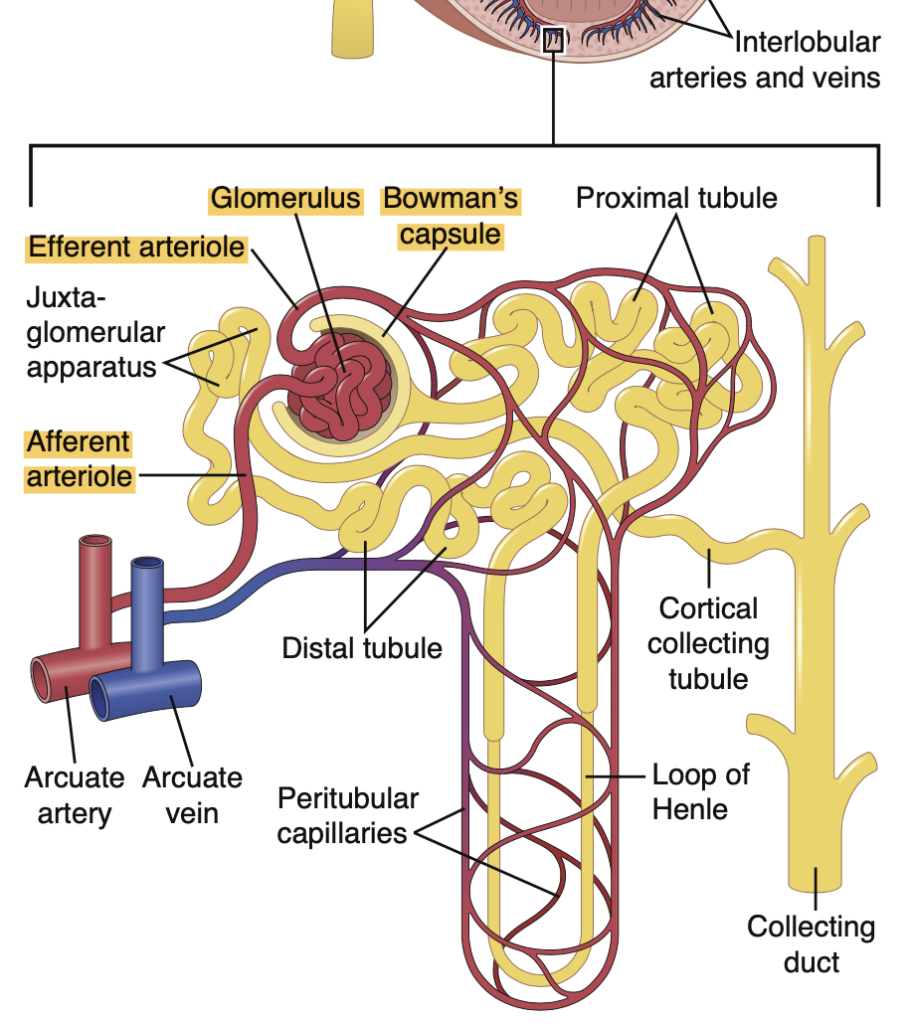
Question 3:Renin
問題文: What molecule catalyzes the formation of angiotensin I?
選択肢:
a) Carbonic anhydrase
b) Calcitriol
c) Erythropoietin
d) Renin
Answer: d) Renin
解説:
レニン(renin)はアンジオテンシノーゲンをアンジオテンシンIに変換する酵素です。これはレニン-アンジオテンシン-アルドステロン系(RAAS)の一部で、血圧と体液バランスの調節に重要です。
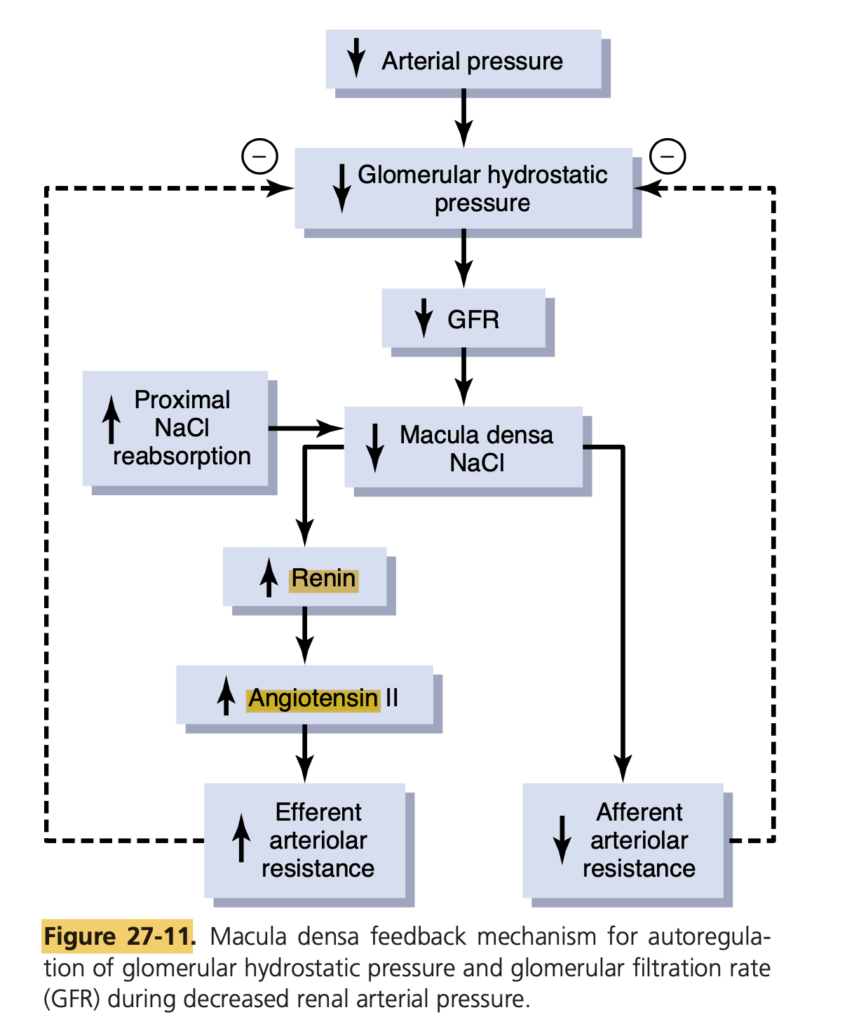
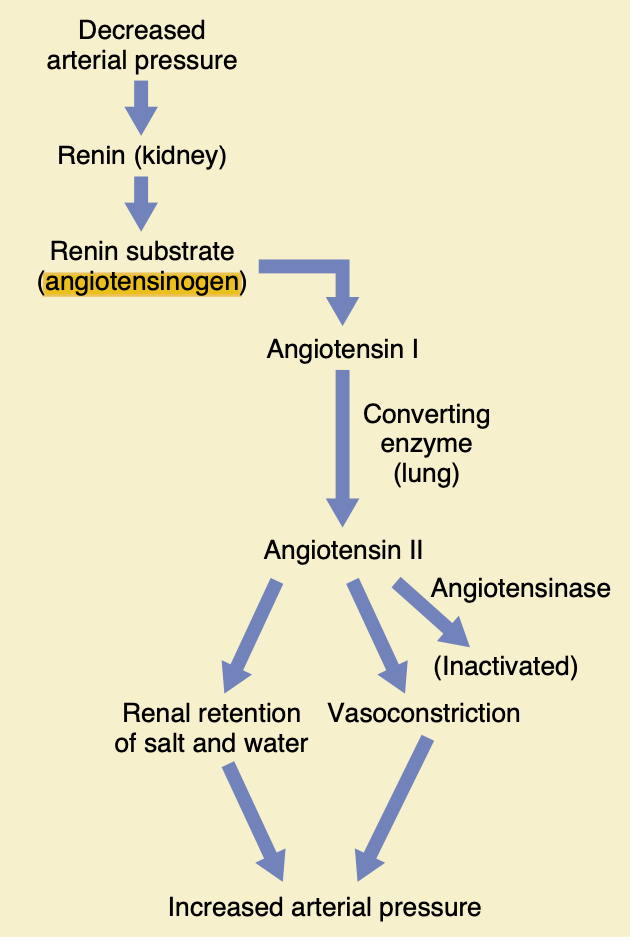
Question 4:女性の平均体水分量
問題文: In women, total body water averages about:
選択肢:
a) 40%
b) 50%
c) 60%
d) 70%
Answer: b) 50%
解説:
女性の平均体水分量は体重の約50%です。男性に比べて体脂肪率が高いため、女性の体水分量はやや低くなります。男性では約60%が一般的です。
Question 5:細胞内液の主要な陽イオン
問題文: Which of the following is NOT a major intracellular fluid cation?
選択肢:
a) Potassium
b) Bicarbonate
c) Magnesium
d) None of the above
Answer: b) Bicarbonate
解説:
細胞内液の主要な陽イオンはカリウム(K⁺)とマグネシウム(Mg²⁺)です。重炭酸イオン(HCO₃⁻)は陰イオンであり、主に細胞外液に存在します。
Question 6:エバンスブルー染料
問題文: Which of the following indicators is used to measure plasma volume?
選択肢:
a) Antipyrine
b) Inulin
c) Evans blue dye
d) Thiosulfate
Answer: c) Evans blue dye
解説:
エバンスブルー染料(Evans blue dye)は血漿量を測定するために使用されます。エバンスブルーは血漿タンパク質と結合し、血管外に拡散しないため、血漿量の測定に適しています。
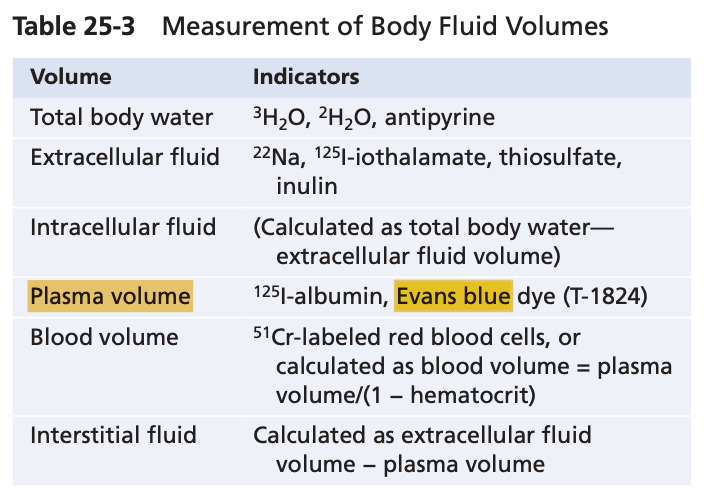
Question 7:浸透と濃度勾配
問題文: What is the primary driving force behind osmosis in biological systems?
選択肢:
a) Gravity
b) Temperature
c) Pressure
d) Concentration gradient
Answer: d) Concentration gradient
解説:
生物学的系における浸透の主な推進力は、濃度勾配です。水分子は、溶質の濃度が高い側に向かって移動し、濃度の均一化を図ります。この現象は、細胞内外の水バランスの調整に重要です。
Question 8:細胞内液
問題文: In the human body, which of the following is the primary fluid compartment that contains the highest percentage of total body water?
選択肢:
a) Intracellular fluid (ICF)
b) Extracellular fluid (ECF)
c) Blood plasma
d) Transcellular fluid
Answer: a) Intracellular fluid (ICF)
解説:
体内の総水分量の約2/3は細胞内液(ICF)に含まれており、これが最も大きな液体コンパートメントです。残りの1/3は細胞外液(ECF)に含まれ、さらに血漿や組織間液に分けられます。
Question 9:ドナン効果
問題文: The Donnan effect primarily occurs when:
選択肢:
a) Two compartments have the same ionic concentrations on both sides of a semipermeable membrane.
b) Impermeable proteins and macromolecules are absent from the cellular environment.
c) A semipermeable membrane separates two compartments with differing ionic concentrations and impermeable solutes.
d) There is an equal distribution of ions across a semipermeable membrane, irrespective of the solute types.
Answer: c) A semipermeable membrane separates two compartments with differing ionic concentrations and impermeable solutes.
解説:
ドナン効果は、不透過性のタンパク質や大きな陰イオンが片側に存在するために、半透膜で仕切られた両側のイオン濃度が異なる場合に発生します。この効果は、イオン分布に不均衡をもたらし、膜電位の発生に寄与します。
Question 10:等張液と赤血球
問題文: If a red blood cell is placed in an isotonic solution, what will happen to the cell?
選択肢:
a) It will shrink and crenate.
b) It will swell and potentially burst.
c) It will remain the same size and shape.
d) It will lose its color and become pale.
Answer: c) It will remain the same size and shape.
解説:
等張液に置かれた赤血球は、外部と細胞内部の浸透圧が同じであるため、水の移動がなく、形状やサイズが変わりません。等張環境では、赤血球は正常な状態を維持します。
Question 11:低ナトリウム血症
問題文: Which of the following symptoms is commonly associated with severe hyponatremia?
選択肢:
a) Hyperactivity and restlessness
b) Muscle hypertrophy
c) Confusion, headache, and nausea
d) Hypertension and bradycardia
Answer: c) Confusion, headache, and nausea
解説:
重度の低ナトリウム血症は、神経系の障害を引き起こすことが多く、混乱、頭痛、吐き気などの症状が一般的です。これらの症状は、細胞内への水の移動によって脳浮腫が発生するためです。
Question 12:尿崩症
問題文: Which of the following medical conditions is a common cause of hypernatremia?
選択肢:
a) Congestive heart failure
b) Diabetes insipidus
c) Syndrome of inappropriate antidiuretic hormone secretion (SIADH)
d) Cirrhosis of the liver
Answer: b) Diabetes insipidus
解説:
尿崩症(diabetes insipidus)は、抗利尿ホルモン(ADH)の欠乏または腎臓の反応不良により、大量の希釈尿が生成されるため、水分損失が増加し、高ナトリウム血症を引き起こすことがあります。
尿崩症(Diabetes Insipidus)は、抗利尿ホルモン(Antidiuretic Hormone, ADH)の欠乏または腎臓のADHに対する反応不良によって引き起こされる疾患です。この状態では、体内での水分保持がうまくいかず、大量の希釈尿が生成されます。以下に詳細な解説を示します。
- 抗利尿ホルモン(ADH)
- ADHは、脳の下垂体後葉から分泌されるホルモンで、腎臓での水の再吸収を促進し、尿量を減らす役割を持ちます。通常、血液の浸透圧が上昇すると、ADHの分泌が増加し、腎臓の集合管での水再吸収が促進され、尿が濃縮されます。
- 尿崩症の種類
- 中枢性尿崩症(Central Diabetes Insipidus): 脳からのADH分泌が不足している状態です。頭部外傷や脳の疾患が原因となることがあります。
- 腎性尿崩症(Nephrogenic Diabetes Insipidus): ADHの分泌は正常ですが、腎臓がADHに反応しない状態です。腎臓の受容体やシグナル伝達経路の異常により発生します。
- 大量の希釈尿の生成
- ADHが不足する、または腎臓がADHに反応しない場合、集合管での水再吸収が減少します。その結果、希釈された尿が多量に生成され、体内の水分が失われます。
- 高ナトリウム血症(Hypernatremia)の発症
- 尿崩症により水分が過剰に失われると、血中のナトリウム濃度が相対的に上昇し、高ナトリウム血症が発生する可能性があります。これは、細胞外液の浸透圧が上昇する原因となり、細胞から水が引き出されることで脱水や神経症状が引き起こされることがあります。
- 治療法
- 中枢性尿崩症の場合、ADH補充療法(デスモプレシンなどの薬剤)が効果的です。
- 腎性尿崩症の場合、食事療法や特定の薬剤(例えば、チアジド系利尿薬)が使用され、腎臓での水排出を調整します。
Question 13:細胞外浮腫
問題文: In which of the following situations is extracellular edema more likely to develop?
選択肢:
a) Increased capillary permeability
b) High plasma protein levels
c) Adequate lymphatic drainage
d) Normal interstitial fluid pressure
Answer: a) Increased capillary permeability
解説:
毛細血管の透過性が増加すると、血液中の液体や溶質が組織間液に漏れ出し、細胞外浮腫が生じやすくなります。他の選択肢は浮腫の発生を抑制する要因です。
Question 14:毛細血管内膠質浸透圧
問題文: Which of the following Starling forces primarily favors the reabsorption of fluid from the interstitial space into the capillaries?
選択肢:
a) Hydrostatic pressure within the interstitial space
b) Hydrostatic pressure within the capillary
c) Osmotic pressure within the interstitial space
d) Osmotic pressure within the capillary
Answer: d) Osmotic pressure within the capillary
解説:
毛細血管内の膠質浸透圧は、間質から毛細血管内へ水を引き戻す力として働き、再吸収を促進します。これは、スターニング力において再吸収を支持する主な力です。
Question 15:細胞内陽イオン
問題文: Which ion is a predominant intracellular cation and is essential for maintaining cellular osmotic balance, while its extracellular levels are largely regulated by hormones such as aldosterone?
選択肢:
a) Sodium (Na⁺)
b) Potassium (K⁺)
c) Calcium (Ca²⁺)
d) Chloride (Cl⁻)
Answer: b) Potassium (K⁺)
解説:
カリウム(K⁺)は主に細胞内に存在する陽イオンであり、細胞の浸透圧バランスの維持に重要です。カリウムの細胞外濃度は、アルドステロンなどのホルモンによって厳密に調節されています。
Question 16:Renin
問題文: In response to low blood pressure, the kidneys release renin, initiating a series of events to increase blood volume and pressure. Which of the following is the correct sequence of actions following the release of renin?
選択肢:
a) Renin activates angiotensinogen to form angiotensin I, which is then converted to angiotensin II, leading to vasoconstriction and aldosterone release.
b) Renin activates aldosterone directly, leading to sodium reabsorption and water retention.
c) Renin converts angiotensin I to angiotensin II, which stimulates the release of antidiuretic hormone (ADH), promoting water reabsorption.
d) Renin directly stimulates the release of antidiuretic hormone (ADH), promoting water reabsorption and vasoconstriction.
Answer: a) Renin activates angiotensinogen to form angiotensin I, which is then converted to angiotensin II, leading to vasoconstriction and aldosterone release.
解説:
レニンはアンジオテンシノーゲンをアンジオテンシンIに変換し、さらにアンジオテンシンIはアンジオテンシン変換酵素(ACE)によってアンジオテンシンIIに変換されます。アンジオテンシンIIは血管収縮とアルドステロン分泌を促進し、血圧と体液量を増加させます。
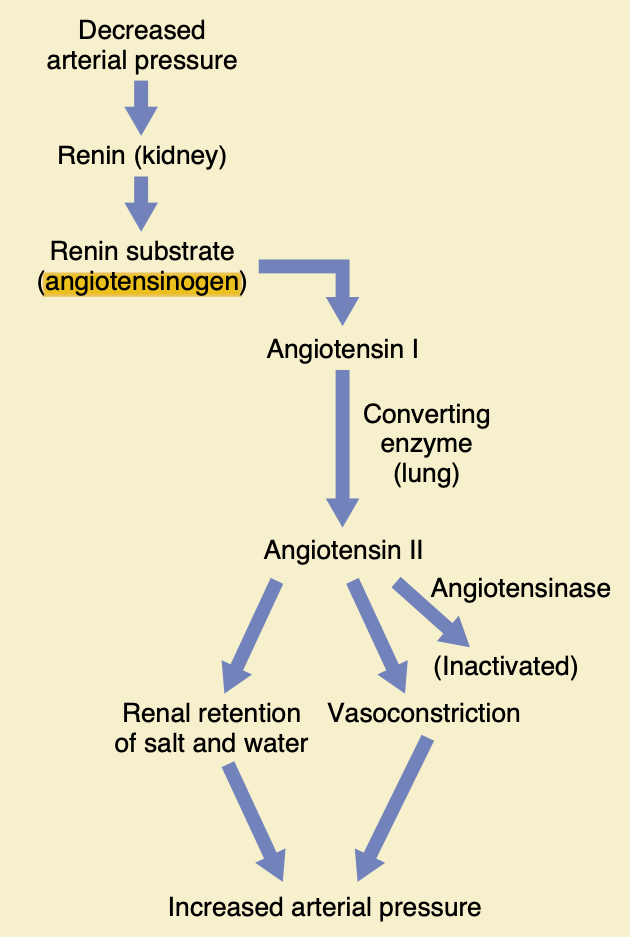
Question 17:Vitamin D₃
問題文: The kidneys play a crucial role in the synthesis of active vitamin D. Which form of vitamin D is produced by the kidneys, and what is its primary function?
選択肢:
a) Vitamin D₂; Regulation of calcium absorption in the small intestine
b) Vitamin D₃; Promotion of bone resorption
c) Vitamin D₃; Facilitation of calcium absorption in the small intestine
d) Vitamin D₂; Inhibition of parathyroid hormone release
Answer: c) Vitamin D₃; Facilitation of calcium absorption in the small intestine
解説:
腎臓で活性型ビタミンD₃(カルシトリオール)が生成され、小腸でのカルシウム吸収を促進します。これは骨の健康維持に不可欠です。
腎臓で生成される活性型ビタミンD₃(カルシトリオール、1,25-ジヒドロキシビタミンD₃)は、体内のカルシウムとリンの代謝を調整し、骨の健康維持に重要な役割を果たしています。以下に詳しい解説を示します。
- ビタミンDの活性化プロセス
- ビタミンDは、日光を浴びることで皮膚で生成される、または食事から摂取されるプロビタミンDがもとになっています。このプロビタミンDは肝臓で1回目の水酸化反応を受け、25-ヒドロキシビタミンD(25(OH)D)になります。
- その後、腎臓に送られ、2回目の水酸化反応を受けることで、活性型の**1,25-ジヒドロキシビタミンD₃(1,25-Dihydroxyvitamin D₃またはカルシトリオール)**が生成されます。このプロセスは、副甲状腺ホルモン(Parathyroid Hormone, PTH)によって促進されます。
- カルシトリオールの作用
- 小腸でのカルシウムとリンの吸収促進: カルシトリオールは小腸の粘膜細胞に作用し、カルシウムとリン酸の吸収を促進します。これにより、血中のカルシウム濃度が増加し、骨の成長と強化に寄与します。
- 腎臓でのカルシウムとリンの再吸収促進: カルシトリオールは腎臓の遠位尿細管にも作用し、尿中へのカルシウム排泄を減少させます。
- 骨代謝の調節: カルシトリオールは骨芽細胞と破骨細胞の活動を調整し、骨の形成と再吸収のバランスを保ちます。必要に応じて、カルシウムが不足している場合には骨からのカルシウム放出を促進します。
- 骨の健康維持における役割
- カルシウムの適正濃度維持: カルシウムは骨の主要成分であり、適切な血中濃度が維持されることで、骨の密度と強度が保たれます。カルシトリオールは、カルシウムの吸収と再吸収を調整し、骨の健康を維持します。
- 骨粗しょう症や骨軟化症の予防: カルシトリオールが不足すると、カルシウムの吸収が低下し、骨のリモデリングが不十分となり、骨が脆くなるリスクが高まります。特に高齢者では、ビタミンD不足が骨粗しょう症の要因となることが多いです。
- カルシトリオールの生成に関与する調節因子
- 副甲状腺ホルモン(PTH): 血中カルシウム濃度が低下するとPTHが分泌され、腎臓でのカルシトリオール生成が促進されます。
- リン濃度: 血中リン濃度が上昇すると、カルシトリオールの生成が抑制されます。これはカルシウムとリンのバランスを保つためです。
- まとめ
- 活性型ビタミンD₃(カルシトリオール)は、腎臓で生成され、腸からのカルシウム吸収を促進し、骨の健康を維持するために不可欠です。腎臓の機能が低下するとカルシトリオール生成が不足し、骨粗しょう症や骨軟化症のリスクが増加することがあるため、腎機能とビタミンDの補充は特に重要です。
Question 18:機能単位
問題文: What is the functional unit of the kidney responsible for filtration, reabsorption, and secretion?
選択肢:
a) Glomerulus
b) Renal corpuscle
c) Nephron
d) Loop of Henle
Answer: c) Nephron
解説:
ネフロンは腎臓の基本的な機能単位であり、糸球体での濾過、尿細管での再吸収と分泌のすべてを行います。
Question 19:輸出細動脈
問題文: After blood is filtered in the glomerulus, what is the immediate vessel that carries the partially filtered blood away from the renal corpuscle?
選択肢:
a) Afferent arteriole
b) Efferent arteriole
c) Renal artery
d) Renal vein
Answer: b) Efferent arteriole
解説:
糸球体で濾過された後、血液は輸出細動脈を通じて腎小体から離れ、次に毛細血管系に流れ込みます。
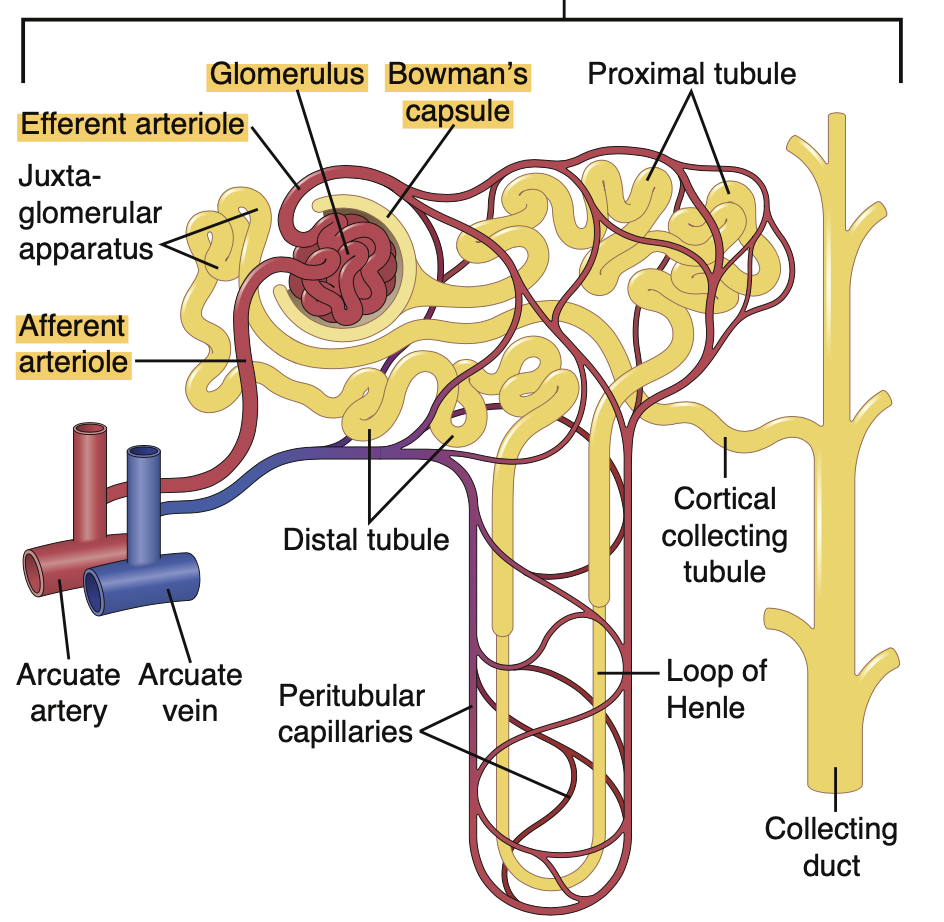
Question 20:Peritubular capillaries
問題文: What is the primary function of the peritubular capillaries in the renal circulation?
選択肢:
a) Filtration of blood
b) Reabsorption of water and solutes
c) Formation of urine
d) Oxygenation of renal tissues
Answer: b) Reabsorption of water and solutes
解説:
尿細管周囲の毛細血管(peritubular capillaries)は、尿細管から水や溶質を再吸収し、血流に戻す役割を担っています。
Question 21:遠位尿細管
問題文: Which part of the renal tubule is responsible for connecting the nephron to the collecting duct and plays a role in the final adjustments to urine composition?
選択肢:
a) Proximal convoluted tubule (PCT)
b) Loop of Henle
c) Distal convoluted tubule (DCT)
d) Connecting tubule
Answer: c) Distal convoluted tubule (DCT)
解説:
遠位尿細管(DCT)はネフロンと集合管をつなぎ、尿の組成調整の最終段階に関与します。ここではナトリウム、カリウム、水などの再吸収が行われます。
ネフロンとは、腎臓の最小単位の構造物で、尿を生成する機能単位です。糸球体と呼ばれるろ過器と尿細管と呼ばれる細長い管から構成されており、腎臓1個に約100万個存在します。
Question 22:傍糸球体装置
問題文: What structure is located at the termination of the ascending limb of the loop of Henle and plays a critical role in sensing the concentration of sodium chloride in the tubular fluid?
選択肢:
a) Juxtaglomerular apparatus
b) Renal corpuscle
c) Glomerulus
d) Bowman’s capsule
Answer: a) Juxtaglomerular apparatus
解説:
傍糸球体装置(JGA)はヘンレループの上行脚の終端に位置し、管内液のナトリウム塩(NaCl)濃度を感知します。これは血圧とGFRの調整において重要です。
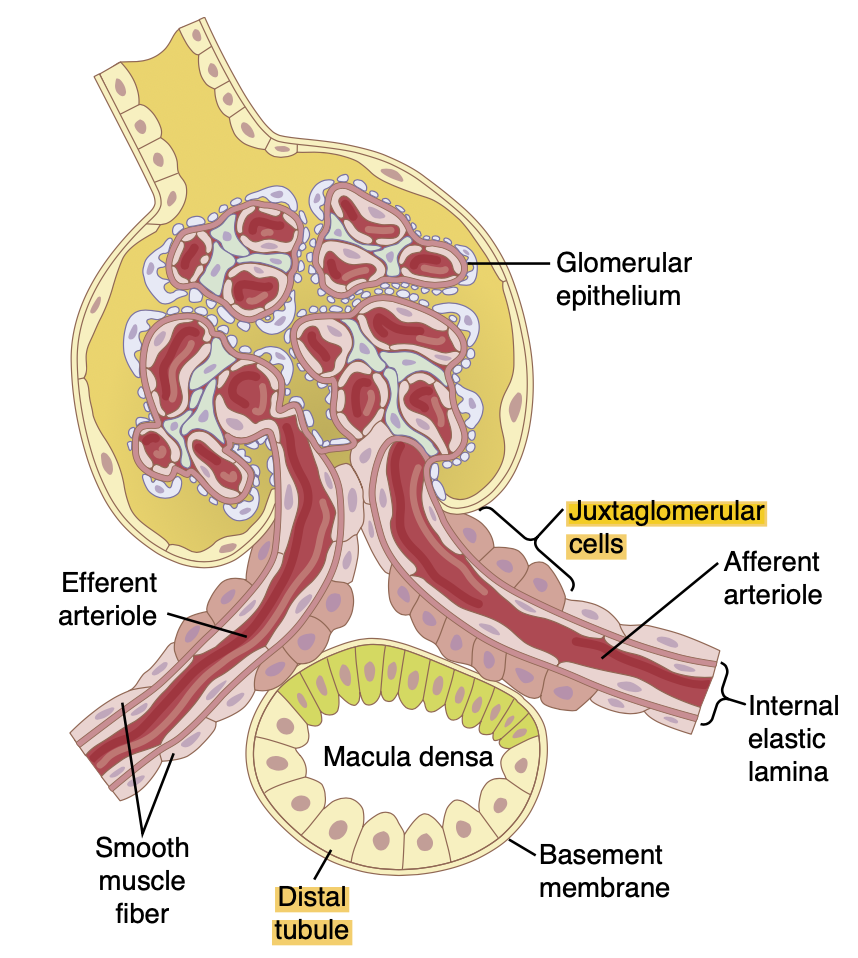
Question 23:ネフロン(皮質&髄質)
問題文: Nephrons can be categorized into two main types based on their location within the kidney. Which of the following statements best describes the structural difference between cortical and juxtamedullary nephrons?
選択肢:
a) Cortical nephrons have a glomerulus that lies deep in the cortex, while juxtamedullary nephrons’ glomeruli lie in the outer cortex.
b) Cortical nephrons have a longer loop of Henle, while juxtamedullary nephrons have a shorter loop of Henle.
c) Cortical nephrons are involved in urine concentration, while juxtamedullary nephrons do not play a role in this function.
d) Cortical nephrons are located in the outer part of the kidney, while juxtamedullary nephrons are situated deep within the renal cortex.
Answer: d) Cortical nephrons are located in the outer part of the kidney, while juxtamedullary nephrons are situated deep within the renal cortex.
解説:
皮質ネフロンは腎皮質の外側に位置し、短いヘンレループを持ちます。対して傍髄質ネフロンは腎皮質の深部に位置し、長いヘンレループを持つため、尿濃縮に重要な役割を果たします。
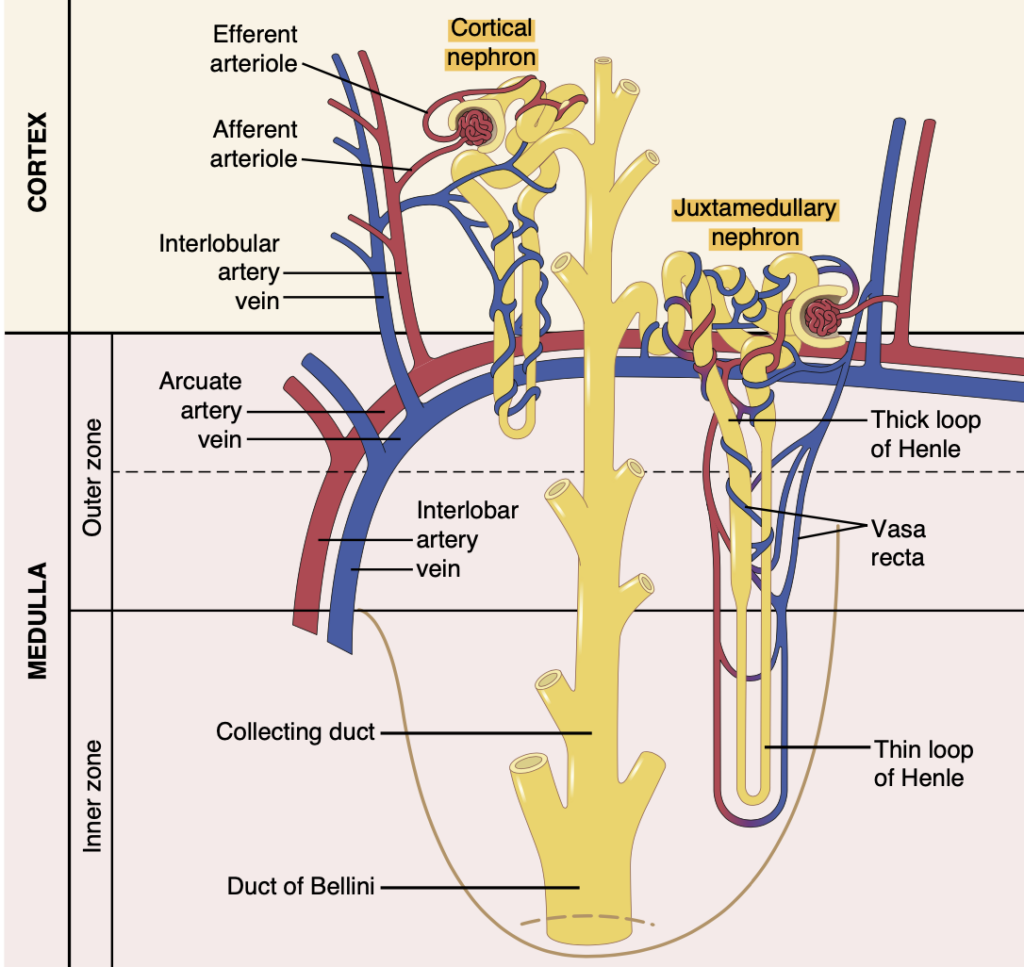
Question 24:デトルサー筋と排尿反射
問題文: The detrusor muscle is a key component of the bladder responsible for:
選択肢:
a) Initiating the micturition reflex
b) Storing urine
c) Reabsorbing water
d) Filtrating blood
Answer: a) Initiating the micturition reflex
解説:
排尿筋(デトルサー筋)は膀胱壁の平滑筋で、収縮により排尿反射(micturition reflex)を開始し、尿を排出します。
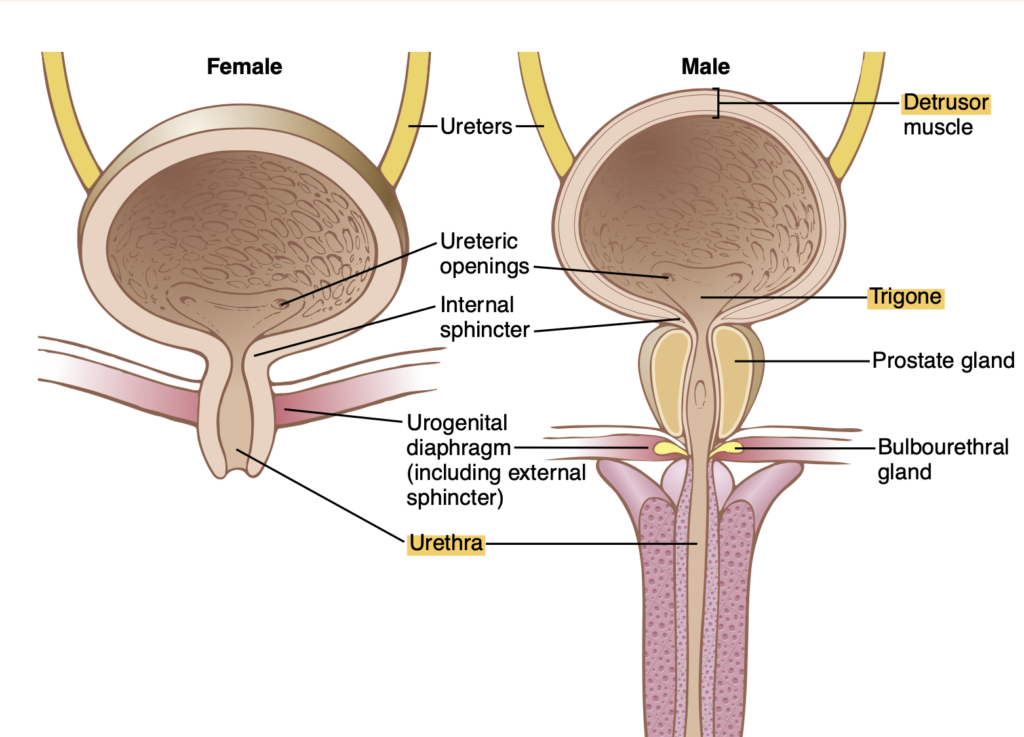
Question 25:デトルサー筋と副交感神経
問題文: Which neural mechanism is responsible for coordinating the contraction of the detrusor muscle and the relaxation of the internal sphincter during the voiding phase of micturition?
選択肢:
a) Sympathetic nervous system
b) Parasympathetic nervous system
c) Somatic nervous system
d) Enteric nervous system
Answer: b) Parasympathetic nervous system
解説:
排尿時のデトルサー筋(膀胱筋)の収縮と内尿道括約筋の弛緩は、副交感神経系によって調整されます。副交感神経の刺激により、膀胱が収縮し、内尿道括約筋が弛緩して尿が排出されます。
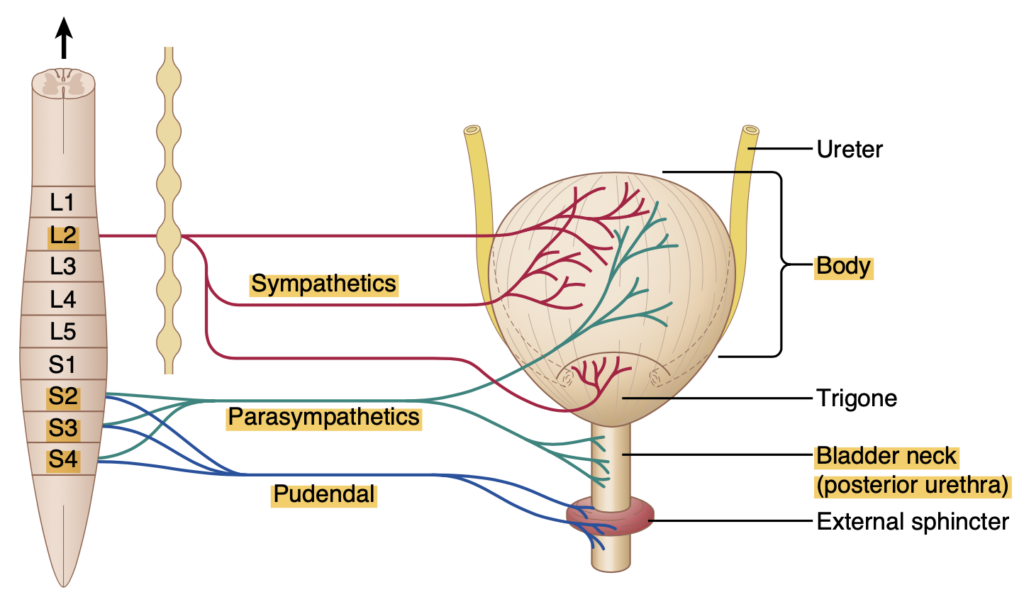
Question 26:外尿道括約筋と体性神経
問題文: Which neural component is responsible for voluntary control over the external urethral sphincter and plays a role in inhibiting the micturition reflex?
選択肢:
a) Sympathetic nervous system
b) Parasympathetic nervous system
c) Somatic nervous system
d) Enteric nervous system
Answer: c) Somatic nervous system
解説:
外尿道括約筋の自発的な制御は体性神経系(somatic nervous system)によって行われます。これにより、排尿反射を抑制し、自分の意思で尿を保持することが可能です。
Question 27:膀胱尿管逆流
問題文: What does the term “vesicoureteral reflux” refer to in the context of urinary physiology?
選択肢:
a) Increased bladder capacity
b) Backward flow of urine from the bladder into the ureters
c) Excessive production of urine in the kidneys
d) Inability to control urination voluntarily
Answer: b) Backward flow of urine from the bladder into the ureters
解説:
膀胱尿管逆流(vesicoureteral reflux)は、尿が膀胱から尿管に逆流する状態を指します。これは通常、膀胱と尿管の接合部の異常が原因で発生し、腎臓への感染リスクを高めます。
Question 28:ストレス尿失禁
問題文: A patient experiences leakage of urine when coughing, sneezing, or laughing. Which condition is most likely responsible for this type of urinary incontinence?
選択肢:
a) Overactive bladder
b) Stress urinary incontinence
c) Neurogenic bladder
d) Overflow incontinence
Answer: b) Stress urinary incontinence
解説:
ストレス尿失禁(stress urinary incontinence)は、咳、くしゃみ、笑いなどで腹圧が増加したときに尿漏れが生じる状態です。骨盤底筋の弱化や尿道括約筋の機能低下が原因です。
過去問2
Question 1:GFRの計算
問題文: A 32-year-old man complaining of fatigue and muscle weakness is seen by his physician. Blood tests reveal a serum glucose level of 325 mg/dL and serum creatinine of 0.8 mg/dL. Results of a 24-hour urine analysis are as follows:
- Total volume = 5L
- Total glucose = 375 g
- Total creatinine = 2.4 g
The patient’s GFR is approximately which of the following?
選択肢:
a) 100 mL/min
b) 125 mL/min
c) 75 mL/min
d) 200 mL/min
e) 275 mL/min
Answer: b) 125 mL/min, d
解説:
GFR(糸球体濾過率)は腎臓の機能を評価する重要な指標です。このケースでは、24時間での尿中クレアチニン排泄量と血清クレアチニンを使用してGFRを計算します。
GFRは以下の式で計算できます:
GFR=(尿中クレアチニン濃度×尿量)/(血清クレアチニン濃度)
この計算に基づき、患者のGFRはおおよそ125 mL/minとなります。したがって、正解はb) 125 mL/minです。
他の選択肢が違う理由:
- a) 100 mL/min: これは計算結果よりも低い値です。実際のクレアチニン排泄量と血清クレアチニンを考慮するとこの値は低すぎます。
- c) 75 mL/min: これは腎機能がさらに低下している状態を示す値であり、患者のデータとは合致しません。
- d) 200 mL/min: これはGFRが高すぎる値であり、通常の健康成人のGFR上限を超えています。
- e) 275 mL/min: 正常範囲を大幅に超えた異常な値であり、この患者の状態ではあり得ません。
GFR=(尿中クレアチニン濃度×尿量)/(血清クレアチニン濃度)
1. 尿中クレアチニン濃度
- 尿中のクレアチニン濃度は、腎臓がどれだけ効率よくクレアチニンを濾過し、尿中に排泄しているかを示します。
- クレアチニンは筋肉の代謝産物で、腎臓によって排泄されるため、クレアチニン濃度の測定は腎機能の指標となります。
2. 尿量
- 24時間または一定の時間内に収集された尿量を測定します。
- この尿量に尿中のクレアチニン濃度を掛けることで、腎臓が排泄したクレアチニンの総量を計算できます。
3. 血清クレアチニン濃度
- 血液中のクレアチニン濃度を測定します。
- 血清クレアチニンは、腎臓がクレアチニンを十分に除去できていない場合に上昇するため、腎機能の状態を反映します。
4. 成人の正常なGFR: 約90〜120 mL/分
- 血清クレアチンが多い(除去できない分が多い)と分ぼが上がるためGFRが低くなる。
GFRの計算式の意義
この式を使うことで、腎臓が単位時間あたりにどれだけのクレアチニンを濾過しているか(つまり腎臓の濾過能力)が分かります。腎機能が正常であれば、GFRは安定した値になりますが、腎障害があるとGFRが低下します。
Question 2:インスリンと近位尿細管
問題文: A 42-year-old woman experiencing peripheral edema is referred to the nephrologist for evaluation of renal function. The patient was diagnosed with type 1 diabetes mellitus at the age of 12 and has been managing her blood glucose with insulin. The major action of insulin on the renal handling of glucose is to:
選択肢:
a) Decreased glomerular filtered load of glucose
b) Decreased glomerular capillary permeability to glucose
c) Increased apical membrane glucose transporters in the proximal tubule
d) Decreased glomerular capillary permeability to glucose
e) Increased basolateral membrane glucose transporter in the proximal tubule
Answer: c) Increased apical membrane glucose transporters in the proximal tubule
解説:
インスリンは血糖の代謝や細胞内への取り込みを促進するホルモンであり、腎臓でも糖の再吸収に影響を与えます。腎近位尿細管では、インスリンがアピカル膜(管腔側膜)におけるグルコース輸送体の数を増加させ、グルコース再吸収が促進されます。これにより、血糖値が正常範囲内であれば、尿中に糖が出ないように調節されています。
他の選択肢が違う理由:
- a) Decreased glomerular filtered load of glucose: 糸球体でのグルコース濾過量は血中グルコース濃度に依存し、インスリン作用とは直接的な関係はありません。
- b) Decreased glomerular capillary permeability to glucose: 糸球体の透過性は、インスリンの作用により直接変化するものではありません。
- d) Decreased glomerular capillary permeability to glucose: 同様に透過性の減少はインスリン作用と関係がありません。
- e) Increased basolateral membrane glucose transporter in the proximal tubule: 基底側膜(血管側)ではなく、管腔側でのグルコース輸送がインスリンにより調節されます。
Question 3:デトルサー筋
問題文: A 38-year-old man presents to his primary care physician complaining of difficulty in voiding for the past 6 months. Impaired detrusor muscle contraction will impede micturition by:
選択肢:
a) Inhibiting the alpha motor neuron to the external bladder sphincter
b) Occluding the urethra
c) Occluding the ureter
d) Diminishing the tension on the bladder wall
e) Increasing parasympathetic nerve activity
Answer: d) Diminishing the tension on the bladder wall
解説:
排尿には膀胱の収縮が必要であり、排尿筋(デトルサー筋)の収縮が弱い場合、膀胱内圧が十分に上がらず、尿の排出が困難になります。この収縮不全により膀胱壁の緊張が減少し、排尿を阻害します。
他の選択肢が違う理由:
- a) Inhibiting the alpha motor neuron to the external bladder sphincter: 外部括約筋への運動神経の抑制は、膀胱自体の収縮不全とは直接関係ありません。
- b) Occluding the urethra: 尿道の閉塞は排尿筋の収縮不全とは別の問題です。
- c) Occluding the ureter: 尿管の閉塞は排尿ではなく尿の輸送に関連し、この症例とは関係ありません。
- e) Increasing parasympathetic nerve activity: 副交感神経活動の増加は膀胱の収縮を促進するため、この症状とは矛盾します。
Question 4:腎血漿流量の測定に使用される典型的な物質
問題文: An 83-year-old woman with a history of hypertension presents to her family physician’s office with oliguria. Serum creatinine and BUN are elevated, and a CT scan reveals that the patient’s left kidney is hypoplastic. Renal function studies are performed to assess the renal handling of various substances. Substance X is injected into an arterial line. All of substance X appears in the urine, and none is detected in the renal vein. What do these findings indicate about the renal handling of substance X?
選択肢:
a) Its clearance is equal to the GFR.
b) Its clearance is equal to the renal plasma flow (RPF).
c) It must be reabsorbed by the kidney.
d) It must be filtered by the kidney.
e) Its urinary concentration must be higher than its plasma concentration.
Answer: b) Its clearance is equal to the renal plasma flow (RPF)
解説:
尿中にのみ物質が排出され、腎静脈中に存在しないことから、この物質は腎臓で完全に除去されています。このような性質を持つ物質は、腎血漿流量(RPF)と同等のクリアランスを持ちます。これは、腎臓に入った物質が全て排出され、再吸収や分泌がないことを示しており、腎血漿流量の測定に使用される典型的な物質の一つです。
他の選択肢が違う理由:
- a) Its clearance is equal to the GFR: GFRは糸球体で濾過される量であり、再吸収や分泌が行われない場合に限定されます。このケースでは腎血漿流量と一致し、GFRのみに相当するものではありません。
- c) It must be reabsorbed by the kidney: 尿中にのみ検出されるため、この物質が腎臓で再吸収されているとは考えられません。
- d) It must be filtered by the kidney: 単に濾過されるだけでなく、完全に排出されています。腎血漿流量を示すために必要な性質が含まれていません。
- e) Its urinary concentration must be higher than its plasma concentration: このケースでは、排出に関する情報のみが示されており、濃度の関係については不明です。
Question 5:近位尿細管のリン酸再吸収
問題文: In the proximal tubule, phosphate reabsorption occurs mainly through:
選択肢:
a) Ultrafiltration
b) Paracellular pathway
c) Enzyme inhibition
d) Passive diffusion
e) Transcellular pathway
Answer: e) Transcellular pathway
解説:
近位尿細管におけるリン酸の再吸収は主にトランスセルラー経路(細胞内経路)を通じて行われます。これは、リン酸輸送体を介して細胞膜を通過し、細胞内で再吸収されるプロセスです。腎臓では、リン酸の再吸収が効率的に行われ、電解質バランスを維持するための重要な役割を果たしています。
他の選択肢が違う理由:
- a) Ultrafiltration: 超濾過は主に糸球体で行われるものであり、リン酸の再吸収には直接関与していません。
- b) Paracellular pathway: 細胞間隙を通過する経路ですが、リン酸は通常この経路を介して再吸収されることは少なく、主にトランスセルラー経路を利用します。
- c) Enzyme inhibition: 酵素の阻害は、再吸収のメカニズムにおいて直接的な役割を果たしません。
- d) Passive diffusion: 受動拡散は濃度勾配に基づくものであり、リン酸再吸収には積極的な輸送機構が必要です。
Question 6:イヌリン
問題文: If the clearance of a substance that is freely filtered is less than that of inulin, which of the following is correct?
選択肢:
a) The substance becomes bound to protein in the tubules.
b) There is net secretion of the substance in the tubules.
c) There is net reabsorption of the substance in the tubules.
d) The substance is neither secreted nor reabsorbed in the tubules.
e) The substance is secreted in the proximal tubule to a greater degree than in the distal tubule.
Answer: c) There is net reabsorption of the substance in the tubules.
解説:
イヌリンは腎臓で完全に濾過され、再吸収も分泌もされないため、GFRを測定するのに適しています。もしある物質のクリアランスがイヌリンよりも低ければ、その物質が糸球体で濾過された後に再吸収されていることを示します。再吸収が行われると、尿中に排出される物質の量が減少し、クリアランスがイヌリン以下になります。
他の選択肢が違う理由:
- a) The substance becomes bound to protein in the tubules: タンパク質結合は濾過率に直接影響しません。
- b) There is net secretion of the substance in the tubules: 分泌がある場合、クリアランスはイヌリンよりも高くなるはずです。
- d) The substance is neither secreted nor reabsorbed in the tubules: 再吸収や分泌がない場合、クリアランスはイヌリンと同等になります。
- e) The substance is secreted in the proximal tubule to a greater degree than in the distal tubule: 分泌があれば、イヌリンのクリアランスより高くなります。
イヌリンの特性(図A)
- 完全に濾過される: イヌリンは糸球体で血液から100%濾過され、尿へと移行します。
- 再吸収も分泌もされない: イヌリンは腎臓の尿細管で再吸収されることも、追加で分泌されることもありません。つまり、濾過された量がそのまま尿として排出されます。
GFR測定におけるイヌリンの利点
- イヌリンが濾過される量は、そのまま尿に現れるため、イヌリンのクリアランス(尿中に排出される量)は、腎臓がどれだけ血液を濾過できるか(GFR)を正確に反映します。
- このため、イヌリンを使って計算されたクリアランスは、実際のGFRと同等になります。
他の物質のクリアランスとイヌリンの比較
- クリアランスがイヌリンより低い場合(図B): もし他の物質のクリアランス(尿中への排泄速度)がイヌリンよりも低い場合、その物質は糸球体で濾過された後、一部が尿細管で再吸収されていることを意味します。たとえば、グルコースやアミノ酸は一度濾過されますが、通常は再吸収されるため、クリアランスはイヌリンよりも低くなります。
- クリアランスがイヌリンより高い場合: 逆に、ある物質がイヌリンよりも高いクリアランスを示す場合、その物質は糸球体で濾過されるだけでなく、尿細管でさらに分泌されていることを示します。例えば、パラアミノ馬尿酸(PAH)は腎臓で分泌されるため、クリアランスがイヌリンよりも高くなります。
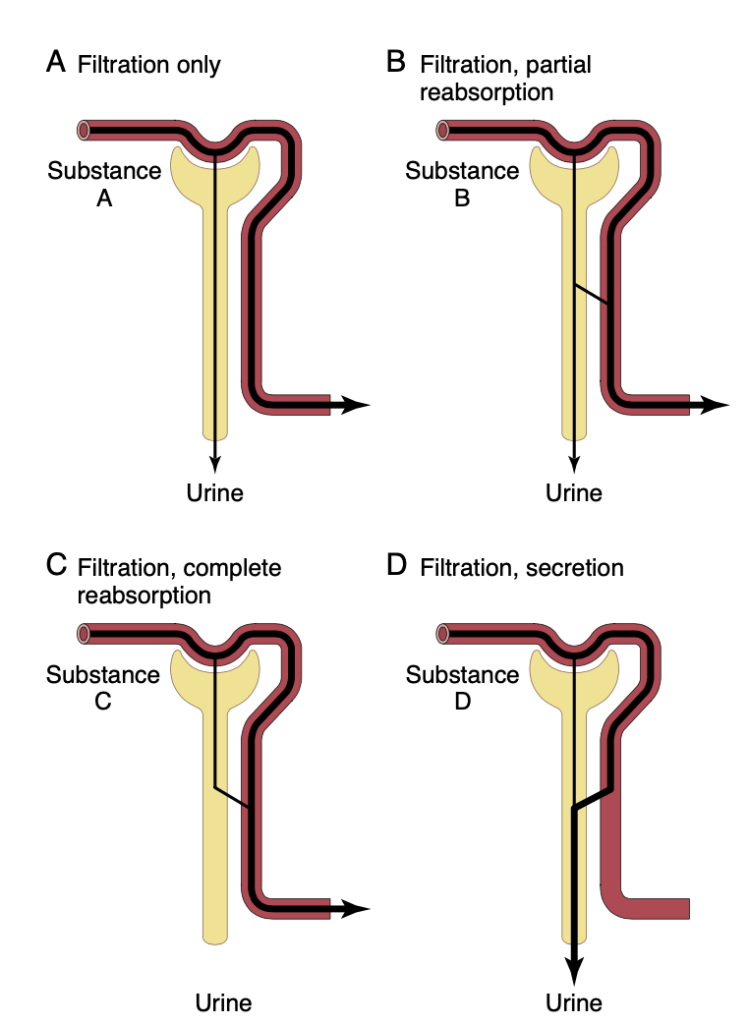
Question 7:尿管腎反射
問題文: Occurs when a ureter becomes blocked and causes pain impulses. The pain impulses cause sympathetic reflex back to the kidney to constrict the renal arterioles and decrease urine output, important in preventing excessive flow of fluid into the pelvis(腎盂) of the kidney.
選択肢:
a) Vesicoureteral reflux
b) Ureterorenal reflex
c) Micturition reflex
d) Nervous reflex
Answer: b) Ureterorenal reflex
解説:
尿管が閉塞すると痛みを引き起こし、交感神経反射が腎臓に戻って腎細動脈を収縮させます。この反射は尿の産生を減少させ、腎盂への過剰な液体流入を防ぐ役割があります。この反応は「尿管腎反射」(Ureterorenal reflex)と呼ばれ、腎臓を保護する重要な反射です。
他の選択肢が違う理由:
- a) Vesicoureteral reflux: 膀胱尿管逆流は尿が膀胱から尿管へ逆流する現象で、尿管閉塞時の反射とは異なります。
- c) Micturition reflex: 排尿反射は膀胱充満による排尿を促す反射であり、腎臓への反射とは関係ありません。
- d) Nervous reflex: 一般的な神経反射ではなく、特定の腎保護反射です。
Question 8:カリウムの排出
問題文: When the dietary intake of K+ increases, body K+ balance is maintained by an increase in K+ excretion primarily by which of the following?
選択肢:
a) Decreased reabsorption of K+ by the thick ascending limb of the loop of Henle
b) Decreased reabsorption of K+ by the proximal tubule
c) Decreased glomerular filtration of K+
d) Increased K+ secretion by the late distal and collecting tubules
e) Shift of K+ into the intracellular compartment
Answer: d) Increased K+ secretion by the late distal and collecting tubules
解説:
カリウム(K+)の摂取量が増加すると、体は主に遠位尿細管と集合管でのカリウム分泌を増加させることでバランスを維持します。これにより、余分なカリウムが尿中に排出され、体内のカリウム濃度が適切な範囲内に保たれます。
他の選択肢が違う理由:
- a) Decreased reabsorption of K+ by the thick ascending limb of the loop of Henle: ヘンレループでは再吸収の減少ではなく、分泌が主に行われます。
- b) Decreased reabsorption of K+ by the proximal tubule: 近位尿細管はカリウム分泌に大きく寄与しません。
- c) Decreased glomerular filtration of K+: 糸球体濾過量はカリウム排出の調整にほとんど関与しません。
- e) Shift of K+ into the intracellular compartment: 細胞内への移動は一時的な調整であり、主な排出手段とはなりません。
Question 9:近位尿細管での尿素と水の再吸収
問題文: Under conditions of normal renal function, which of the following is true of the concentration of urea in tubular fluid at the end of the proximal tubule?
選択肢:
a) It is higher than the concentration of urea in the plasma
b) It is higher than the concentration of urea in tubular fluid at the tip of the loop of Henle
c) It is higher than the concentration of urea in the final urine in antidiuresis
d) It is lower than plasma urea concentration because of active urea reabsorption along the proximal tubule
Answer: a) It is higher than the concentration of urea in the plasma
解説:
尿素は近位尿細管で一部再吸収されますが、同時に水の再吸収も起こるため、尿細管液中の尿素濃度は血漿よりも高くなります。これは、尿細管液中の水の減少によって相対的に尿素濃度が上昇するためです。
他の選択肢が違う理由:
- b) It is higher than the concentration of urea in tubular fluid at the tip of the loop of Henle: ループ先端では尿素濃度がさらに高くなる可能性があり、この選択肢は正確ではありません。
- c) It is higher than the concentration of urea in the final urine in antidiuresis: 抗利尿状態では最終尿の尿素濃度が高くなるため、この選択肢は誤りです。
- d) It is lower than plasma urea concentration because of active urea reabsorption along the proximal tubule: 尿素の再吸収はありますが、濃度が下がるほどの再吸収は行われません。
尿素は腎臓の尿細管を通過する際に、特に近位尿細管で一部が再吸収されます。しかし、尿素が再吸収されると同時に、水も近位尿細管で再吸収されます。このため、尿細管内の水の量が減少し、相対的に尿細管内の尿素濃度が高くなるという現象が生じます。
- 尿素と水の再吸収
- 近位尿細管では、まず水が再吸収され、次に尿素が一部再吸収されます。この過程で、尿細管内の水の量が減少します。
- 濃縮のメカニズム
- 尿細管内の水が減少することで、残っている尿素の濃度が相対的に高くなります。つまり、水が再吸収されることで、尿素が「濃縮」された状態になります。
- 尿細管液中の尿素濃度が血漿より高くなる理由
- 血液から尿細管に濾過された段階では、尿素の濃度は血漿と同じですが、近位尿細管で水分が再吸収されると、尿細管液中の尿素濃度が上昇します。これは、尿細管内の液体の量が減少し、尿素が相対的に濃縮されるためです。
Question 10:管糸球体フィードバック
問題文: Links changes in NaCl concentration at the macula densa with the control of renal arteriolar resistance and autoregulation of GFR.
選択肢:
a) Tubuloglomerular feedback
b) Myogenic mechanism
c) Ureterorenal reflex
d) Micturition Reflex Cycle
e) Myogenic reflex
Answer: a) Tubuloglomerular feedback
解説:
ナトリウム塩(NaCl)濃度の変化が緻密斑(マクラデンサ)で感知されると、糸球体濾過量(GFR)の自己調節が行われます。この機構は「管糸球体フィードバック」(Tubuloglomerular feedback)と呼ばれ、腎小動脈の抵抗を調整してGFRを一定に保つ役割を果たします。
他の選択肢が違う理由:
- b) Myogenic mechanism: 筋原性メカニズムは血管壁の圧力変化に対する反応で、緻密斑のNaCl濃度変化に基づく調整ではありません。
- c) Ureterorenal reflex: 尿管の閉塞に関連する反射であり、GFRの調整には関与しません。
- d) Micturition Reflex Cycle
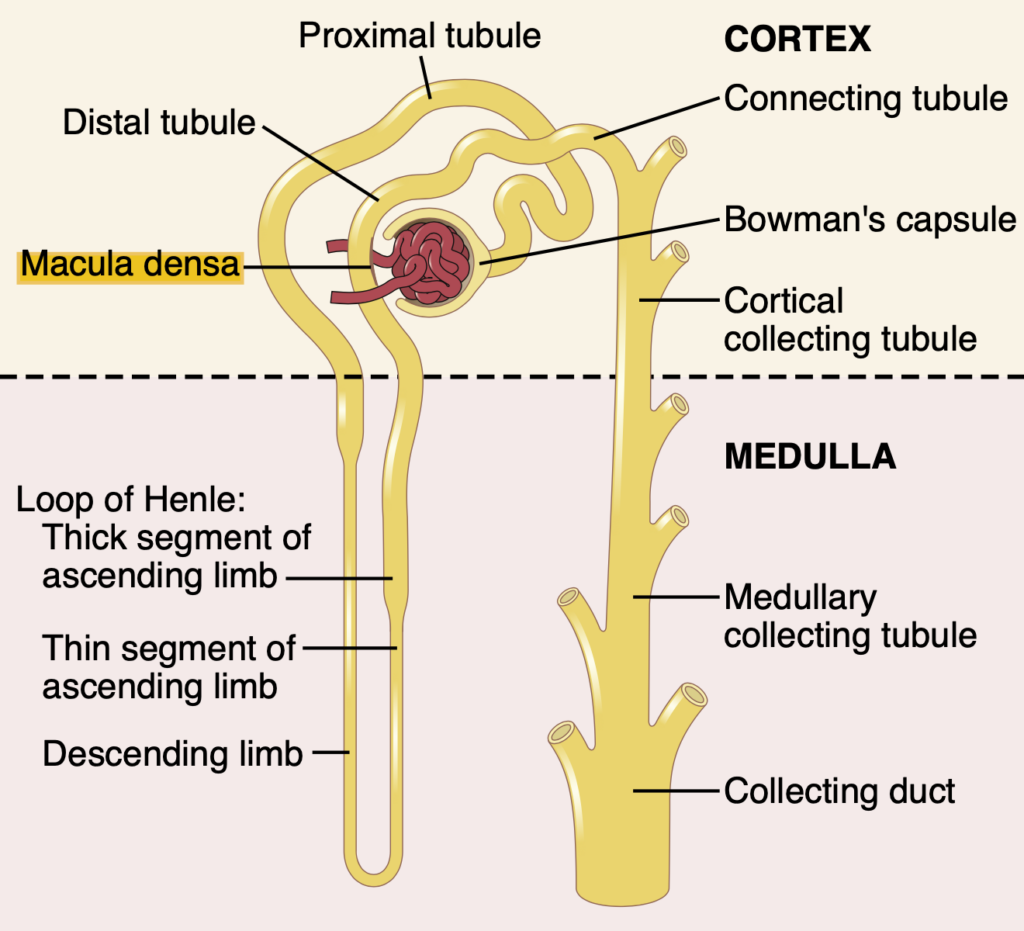
Question 11:近位尿細管でのアミノ酸の再吸収
問題文: A 10-year-old boy is brought to the emergency department with severe left flank(脇腹) pain, nausea, vomiting, and hematuria. He has a family history of recurrent kidney stones. Urinalysis shows hexagonal crystals, and radiograph reveals a stone in the left ureter. The boy’s condition is likely due to a defect in amino acid reabsorption in the kidney. What part of the kidney is responsible for the majority of amino acid reabsorption?
選択肢:
a) Collecting Tubules
b) Ascending loop of Henle
c) Proximal tubule
d) Descending loop of Henle
Answer: c) Proximal tubule
解説:
アミノ酸の再吸収は主に近位尿細管(proximal tubule)で行われます。この部分は、多くの溶質や栄養素の再吸収に関与しており、アミノ酸の再吸収障害がある場合、尿中にアミノ酸が排出されることがあります。この症状は遺伝的なアミノ酸代謝障害(例: シスチン尿症)に起因し、腎結石を引き起こすことが多いです。
他の選択肢が違う理由:
- a) Collecting Tubules: 集合管はアミノ酸再吸収の主な場所ではありません。
- b) Ascending loop of Henle: 上行脚はNa⁺とCl⁻の再吸収が主で、アミノ酸の再吸収には関与しません。
- d) Descending loop of Henle: 下行脚もアミノ酸再吸収に関与していません。
Question 12:ヘンレループでのマグネシウムの再吸収
問題文: The primary site of reabsorption of magnesium is located in which portion?
選択肢:
a) Collecting Tubules
b) Medullary duct
c) PCT
d) DCT
e) Loop of Henle
Answer: e) Loop of Henle
解説:
マグネシウムの再吸収は主にヘンレループで行われ、その中でも厚い上行脚が重要な役割を果たします。腎臓における電解質バランスの調節は、血中マグネシウム濃度を維持する上で重要です。
他の選択肢が違う理由:
- a) Collecting Tubules: 集合管でのマグネシウム再吸収は限定的です。
- b) Medullary duct: 髄質管は主に尿濃縮に関与し、マグネシウム再吸収には関与しません。
- c) PCT: 近位尿細管での再吸収はありますが、主な部位はヘンレループです。
- d) DCT: 遠位尿細管では一部再吸収されますが、主要な部位ではありません。
Question 13:高カリウム血症
問題文: Which of the following statements best describes renal ammonia (NH3)?
選択肢:
a) NH3 is classified as a titratable acid.
b) NH3 excretion reduces the concentration of bicarbonate in the plasma.
c) The tubular epithelial cells are impermeable to NH3.
d) Renal NH3 synthesis is decreased in hyperkalemia.
e) The majority of NH3 is produced by epithelial cells in the distal nephron.
Answer: d) Renal NH3 synthesis is decreased in hyperkalemia
解説:
腎臓でのアンモニア(NH3)合成は高カリウム血症(hyperkalemia)により抑制されます。NH3は腎臓で生成され、酸塩基バランスの維持に寄与していますが、カリウム濃度の上昇によりその産生が低下します。
なぜアンモニア生成が抑制されるのか
高カリウム血症では、腎臓の細胞がカリウムを体外に排出しようとするため、アンモニア生成が優先されなくなります。
その結果、体内の酸を十分に中和できなくなり、酸塩基バランスが崩れる可能性があります。
他の選択肢が違う理由:
- a) NH3 is classified as a titratable acid: NH3自体は揮発性の塩基であり、滴定酸ではありません。
- b) NH3 excretion reduces the concentration of bicarbonate in the plasma: アンモニアの排出は、重炭酸濃度の低下には直接影響しません。
- c) The tubular epithelial cells are impermeable to NH3: 管状上皮細胞はNH3に対して透過性があります。
- e) The majority of NH3 is produced by epithelial cells in the distal nephron: NH3の主要な生成は近位尿細管で行われます。
Question 14:腎動脈への圧力とレニン分泌
問題文: Compared with the right kidney, the left kidney will have an increased rate of which of the following due to hypertensive retinopathy and intolerance to ACE inhibitors?
選択肢:
a) Glomerular capillary pressure
b) Rate of sodium excretion
c) Rate of renin secretion
d) Rate of renin secretion
e) Rate of urine formation
Answer: c) Rate of renin secretion
解説:
左腎動脈に圧力がかかることで血流が減少し、レニン分泌が増加します。高血圧による腎臓の適応反応として、低酸素状態に対応するため、左腎はレニン分泌を増加させて血圧を上昇させようとします。
他の選択肢が違う理由:
- a) Glomerular capillary pressure: 糸球体圧力は異なる機構によって影響を受けます。
- b) Rate of sodium excretion: ナトリウム排泄速度の上昇は直接の反応ではありません。
- d) Rate of renin secretion: この選択肢は重複です。
- e) Rate of urine formation: 尿生成率の増加はこの状況においては予想されません。
Question 15:Na⁺-K⁺ポンプ
問題文: A patient with uncontrolled hypertension is placed on a new diuretic targeting Na+ reabsorption from the basolateral surface of renal epithelial cells. Which transport process is affected by the new drug?
選択肢:
a) Solvent drag
b) Na+/H+ exchange
c) Na+ -glucose cotransport
d) Facilitated diffusion
e) Na+ -K+ pump
Answer: e) Na+ -K+ pump
解説:
新しい利尿薬は腎上皮細胞の基底側膜にあるNa⁺-K⁺ポンプに作用し、ナトリウム再吸収を減少させることで血圧を低下させます。Na⁺-K⁺ポンプは細胞からナトリウムを排出し、カリウムを取り込むため、ナトリウムバランスと細胞内電位の維持に不可欠です。
他の選択肢が違う理由:
- a) Solvent drag: 溶質のドラッグは主に溶媒とともに移動するものであり、Na⁺-K⁺ポンプには関与しません。
- b) Na+/H+ exchange: この交換は酸塩基バランスに関わりますが、直接的なナトリウム排出には影響しません。
- c) Na+ -glucose cotransport: これは近位尿細管でのNa⁺再吸収に関与しますが、利尿薬のターゲットにはなりません。
- d) Facilitated diffusion: 拡散は能動的輸送とは異なり、ポンプに依存しません。
新しい利尿薬は、腎臓の細胞にあるNa⁺-K⁺ポンプに作用することで、ナトリウムの再吸収を減少させ、結果的に血圧を低下させます。以下に、このメカニズムについてわかりやすく解説します。
Na⁺-K⁺ポンプの役割
- Na⁺-K⁺ポンプは、腎臓の尿細管上皮細胞の基底側膜(血管側)にある重要なポンプで、ナトリウムイオン(Na⁺)とカリウムイオン(K⁺)を交換する働きを持っています。
- 通常、Na⁺-K⁺ポンプはナトリウムを尿細管細胞から血液に送り出し、その代わりにカリウムを取り込みます。このプロセスにより、ナトリウムが体内に再吸収され、体液量が増え、血圧が維持されます。
利尿薬の作用
- 新しい利尿薬は、このNa⁺-K⁺ポンプの働きを抑制します。
- ポンプの活動が抑えられると、ナトリウムが血液に再吸収されにくくなり、尿中に多くのナトリウムが排出されます。
- ナトリウムは水分を引き寄せる性質があるため、ナトリウムが尿とともに排出されると、尿量が増加し、体内の水分量が減少します。
血圧の低下
- 体内の水分が減ると、血液量も減少し、血圧が低下します。
- 利尿薬によってナトリウムと水が効率的に排出されるため、血圧を下げる効果が期待できます。
Question 16:近位尿細管と水分再吸収率
問題文: Which part of the nephron normally reabsorbs the most water?
選択肢:
a) Proximal tubule
b) Ascending loop of Henle
c) Descending loop of Henle
d) Collecting tubules
e) Early distal tubule
Answer: a) Proximal tubule
解説:
水の再吸収の大部分は近位尿細管で行われ、総再吸収量の約70%に相当します。これは、体液バランスを維持するために非常に重要です。
他の選択肢が違う理由:
- b) Ascending loop of Henle: この部位では水の再吸収は行われません。
- c) Descending loop of Henle: 水は再吸収されますが、全体の量としては近位尿細管に劣ります。
- d) Collecting tubules: 集合管でも再吸収は行われますが、全体の一部です。
- e) Early distal tubule: この部位では水の再吸収は限られています。
Question 17:傍髄質(Juxtamedullary)
問題文: This type of nephron has glomeruli that lie deep in the renal cortex near the medulla and has long loops of Henle that dip deeply into the medulla.
選択肢:
a) Juxtamedullary nephrons
b) Descending nephrons
c) Pelvic nephrons
d) Cortical nephrons
Answer: a) Juxtamedullary nephrons
解説:
傍髄質(Juxtamedullary)ネフロンは腎皮質の深部に位置し、長いヘンレループが髄質に深く入り込みます。この構造は、尿を濃縮するために重要であり、腎臓の濃縮勾配を維持する役割を果たします。
他の選択肢が違う理由:
- b) Descending nephrons: こうしたネフロンは存在せず、選択肢として不適切です。
- c) Pelvic nephrons: 腎骨盤に関係するネフロンはありません。
- d) Cortical nephrons: 皮質ネフロンは浅い部分にあり、短いヘンレループを持つため、尿の濃縮にはあまり寄与しません。
Question 18:うっ血性心不全や循環血液量への腎血流の反応
問題文: A 56-year-old man is admitted with an acute myocardial infarction and has reduced urinary output a few days later. An increase in which of the following contributes to reduced urine flow in a patient with congestive heart failure and reduced effective circulating volume?
選択肢:
a) Renal perfusion pressure
b) Renal sympathetic nerve activity
c) Sodium delivery to the macula densa
d) ANP
e) Urodilatin (renal natriuretic peptide)
Answer: b) Renal sympathetic nerve activity
解説:
うっ血性心不全や循環血液量が減少した場合、腎交感神経の活動が増加し、腎臓の血流を減少させます。この結果、尿生成が抑制され、体液を保持することで血圧を維持しようとする反応が引き起こされます。
他の選択肢が違う理由:
- a) Renal perfusion pressure: 腎灌流圧は減少する傾向にあり、増加ではありません。
- c) Sodium delivery to the macula densa: マクラデンサへのナトリウム供給量は減少します。
- d) ANP: 心房性ナトリウム利尿ペプチド(ANP)は体液量が多い場合に分泌され、利尿効果を持つため、この状況とは逆の働きをします。
- e) Urodilatin: 尿細管での利尿を促進するホルモンであり、循環血液量を減少させる状況では作用しません。
うっ血性心不全や循環血液量が減少すると、腎臓が血液量の不足を感じ取り、体液を保持して血圧を維持しようとする反応が起こります。これについて、わかりやすく説明します。
1. 腎交感神経の活動が増加する理由
- うっ血性心不全や循環血液量の減少が起こると、体は「血液が足りない」「血圧が低い」と認識します。
- これに対応して、腎臓への指令を伝える腎交感神経の活動が増加します。交感神経は、血圧や体液バランスを維持するための「体の緊急反応」を引き起こします。
2. 腎臓の血流が減少する
- 腎交感神経の活動が増加すると、腎臓への血流を減少させるように働きます。腎臓の血管が収縮し、血液が腎臓にあまり流れなくなるためです。
- 血流が減ると、腎臓での尿生成が抑制され、尿量が減少します。
3. 体液を保持する反応
- 尿生成が抑制されることで、体内に水分が保持され、血液量が維持されます。
- これは、血圧を低下させないようにするための生理的な仕組みです。体が水分を保持することで、血圧が低下するのを防ぎ、重要な臓器への血流が確保されます。
4. 結果としての血圧維持
- 体液保持の効果により、血液量が増え、血圧を維持することができます。この反応は、血圧が下がりすぎるのを防ぎ、循環器系を安定させるための重要な防御反応です。
Question 19:チアジド感受性ナトリウム-塩素共輸送体(NCCT)
問題文: A 17-year-old male presents with fatigue, muscle cramps, and joint pain. Blood analysis reveals hypokalemia, hypomagnesemia, and hypochloremic metabolic alkalosis. Urinalysis shows decreased urinary chloride and calcium. The clinical findings suggest a mutation of the SLC12A3 gene affecting the thiazide-sensitive sodium-chloride cotransporter (NCCT). Electrically neutral active transport of sodium and chloride occurs in which area of the nephron?
選択肢:
a) Medullary collecting duct
b) Cortical collecting duct
c) Descending limb of the loop of Henle
d) Thin ascending limb of the loop of Henle
e) Distal tubule
Answer: e) Distal tubule
解説:
チアジド感受性ナトリウム-塩素共輸送体(NCCT)は遠位尿細管で機能し、ここでナトリウムと塩素の電気的に中性な活性輸送が行われます。SLC12A3遺伝子の変異により、この輸送が障害され、低カリウム血症や代謝性アルカローシスなどが生じます。
他の選択肢が違う理由:
- a) Medullary collecting duct: 髄質集合管は水と尿素の調節が主で、Na⁺/Cl⁻の共輸送は行いません。
- b) Cortical collecting duct: 皮質集合管は主にナトリウムとカリウムの交換を行いますが、NCCTは含まれていません。
- c) Descending limb of the loop of Henle: この部位は水の再吸収が主で、Na⁺/Cl⁻の共輸送は行いません。
- d) Thin ascending limb of the loop of Henle: 上行脚ではナトリウムが再吸収されますが、NCCTは存在しません。
Question 20:Podocytes
問題文: A 20-year-old woman has a trace of protein in her urinalysis. A defect in what cells could be causing the leakage of protein?
選択肢:
a) Pericytes
b) Podocytes
c) Mesangial cells
d) Bowman’s capsule cells
Answer: b) Podocytes
解説:
ポドサイト(足細胞)は糸球体の濾過障壁の一部を形成しており、タンパク質の漏出を防ぐ役割を持っています。これらの細胞に異常があると、タンパク尿が発生することがあります。ポドサイトの障害は、腎臓の糸球体濾過機能に直接影響を及ぼし、蛋白の漏出を引き起こすことが確認されています。
他の選択肢が違う理由:
- a) Pericytes: ペリサイトは血管の支持細胞であり、糸球体濾過に関与していません。
- c) Mesangial cells: メサンギウム細胞は糸球体内での構造維持と免疫応答に関与しますが、濾過障壁には直接関与しません。
- d) Bowman’s capsule cells: ボウマン嚢の細胞は濾過バリアの一部ではなく、ポドサイトのようにタンパク質漏出を防ぐ役割を持っていません。
Question 21:デトルサー筋
問題文: A patient with a history of insulin-dependent diabetes mellitus presents with difficulty in voiding(排泄する). Cystometry shows a weak contraction of the detrusor muscle. Which of the following changes in bladder volume will most likely occur in this patient?
選択肢:
a) Increased pre-void volume
b) Increased rate of filling from the ureters
c) Decreased postvoid residual volume
d) Increased rate of emptying through the urethra
Answer: a) Increased pre-void volume
解説:
排尿筋(デトルサー筋)の収縮が弱い場合、排尿前の膀胱容量(pre-void volume)が増加します。デトルサー筋が効果的に収縮できないと、尿が十分に排出されず、膀胱に尿が溜まってしまいます。これにより、排尿直前の膀胱内の尿量が増加します。
他の選択肢が違う理由:
- b) Increased rate of filling from the ureters: 尿管からの充填率は変化しません。
- c) Decreased postvoid residual volume: 残尿量はむしろ増加する傾向にあります。
- d) Increased rate of emptying through the urethra: 排尿率は弱い収縮により低下します。
Question 22:糸球体毛細血管と静水圧
問題文: The glomerulus contains a network of glomerular capillaries that have high hydrostatic pressure compared to other capillaries. What is this pressure?
選択肢:
a) 80 mmHg
b) 75 mmHg
c) 60 mmHg
d) 120 mmHg
e) 50 mmHg
Answer: c) 60 mmHg
解説:
糸球体の毛細血管は高い静水圧(約60 mmHg)を維持しており、これは他の体内の毛細血管よりも高いため、糸球体濾過が効果的に行われます。この高圧は、腎臓における濾過速度(GFR)を維持するために重要です。
他の選択肢が違う理由:
- a) 80 mmHg: 80 mmHgは高すぎます。
- b) 75 mmHg: 75 mmHgも実際の糸球体圧より高く設定されています。
- d) 120 mmHg: 120 mmHgは非常に高く、腎臓の生理的静水圧範囲を超えます。
- e) 50 mmHg: 50 mmHgは実際の糸球体圧よりも低く設定されています。
Question 23:対向流増幅機構
問題文: Interaction of filtrate flow in the ascending and descending limbs of nephron loops in juxtamedullary nephrons is referred to as which of the following?
選択肢:
a) None of the above
b) Both
c) Countercurrent exchanger
d) Countercurrent multiplier
Answer: d) Countercurrent multiplier
解説:
傍髄質ネフロンにおける上行脚と下行脚の流れの相互作用は「対向流増幅機構」(countercurrent multiplier)と呼ばれ、尿濃縮に重要です。この機構により、腎髄質の浸透圧勾配が形成され、最終的に濃縮された尿が生成されます。
他の選択肢が違う理由:
- a) None of the above: 対向流増幅機構が正しい回答です。
- b) Both: 対向流増幅機構のみが正解です。
- c) Countercurrent exchanger: 対向流交換機構は血液循環に関連し、尿濃縮とは異なります。
Question 24:Norepinephrine
問題文: All of the following are physiological factors that increase GFR EXCEPT:
選択肢:
a) Endothelin-derived NO
b) Bradykinin
c) Prostaglandins
d) Norepinephrine
Answer: d) Norepinephrine
解説:
ノルエピネフリンは血管収縮を引き起こし、腎臓の血流を減少させ、糸球体濾過率(GFR)を低下させます。一方、NO、ブラジキニン、プロスタグランジンは血管を拡張し、GFRを増加させます。
他の選択肢が違う理由:
- a) Endothelin-derived NO: 血管拡張を引き起こし、GFRを増加させます。
- b) Bradykinin: 血管拡張によりGFRを増加させます。
- c) Prostaglandins: 血管拡張効果があり、GFRを増加させます。
Question 25:ビタミンD3
問題文: Which of the following factors does not decrease the excretion of calcium?
選択肢:
a) Hypotension
b) Vitamin D3
c) Hyperparathyroidism
d) Metabolic alkalosis
Answer: b) Vitamin D3
解説:
ビタミンD3はカルシウムの吸収を促進し、カルシウムの排泄を減少させる役割はありません。むしろ、血中カルシウム濃度を増加させるため、カルシウムの腎排泄を高める傾向があります。他の選択肢はすべてカルシウムの排泄を低下させる要因です。
他の選択肢が違う理由:
- a) Hypotension: 低血圧は腎血流を減少させ、カルシウムの排泄を抑制します。
- c) Hyperparathyroidism: 副甲状腺ホルモンはカルシウム再吸収を促進し、排泄を減少させます。
- d) Metabolic alkalosis: 代謝性アルカローシスではカルシウムの尿中排泄が減少します。
Question 26:aldosterone
問題文: On which of the following does aldosterone exert its greatest effect?
選択肢:
a) Cortical collecting duct
b) Proximal tubule
c) Glomerulus
d) Thin portion of the loop of Henle
e) Thick portion of the loop of Henle
Answer: a) Cortical collecting duct
解説:
アルドステロンは主に皮質集合管(cortical collecting duct)で作用し、ナトリウムの再吸収とカリウムの分泌を促進します。このホルモンは血圧調節と電解質バランスの維持に重要な役割を果たします。集合管の細胞において、アルドステロンはナトリウムポンプやカリウムチャネルの活性を増加させ、体内のナトリウム保持とカリウム排泄を助けます。
他の選択肢が違う理由:
- b) Proximal tubule: アルドステロンの作用はほとんどなく、ナトリウム再吸収の大部分は近位尿細管での独立した機構で行われます。
- c) Glomerulus: 糸球体には直接作用せず、糸球体での濾過機能には影響しません。
- d) Thin portion of the loop of Henle: ここでのナトリウムや水の移動は主に受動的なもので、アルドステロンは関与しません。
- e) Thick portion of the loop of Henle: 厚い上行脚ではナトリウムの再吸収が行われますが、アルドステロンはここでの再吸収には関与しません。
Question 27:近位尿細管でのH⁺の輸送
問題文: The transport of H+ into the proximal tubule is primarily associated with which of the following?
選択肢:
a) Excretion of potassium ion
b) Reabsorption of bicarbonate ion
c) Excretion of ammonium ion
d) Reabsorption of phosphate ion
e) Reabsorption of calcium ion
Answer: b) Reabsorption of bicarbonate ion
解説:
近位尿細管でのH⁺(水素イオン)の輸送は主に重炭酸イオン(HCO₃⁻)の再吸収と関連しています。H⁺は管腔内で重炭酸イオンと反応し、二酸化炭素と水に変換されます。その後、細胞内で再びH⁺とHCO₃⁻に分解され、重炭酸イオンが再吸収されます。これは酸塩基バランスの維持に重要な役割を果たします。
他の選択肢が違う理由:
- a) Excretion of potassium ion: H⁺の輸送とカリウム排泄は直接関連していません。
- c) Excretion of ammonium ion: NH₄⁺(アンモニウム)の排泄は酸塩基バランスに関与しますが、主に集合管で調整されます。
- d) Reabsorption of phosphate ion: リン酸再吸収にはH⁺の輸送は関与しません。
- e) Reabsorption of calcium ion: カルシウム再吸収もH⁺の輸送と関連していません。
Question 28:血漿浸透圧
問題文: Jared and Adam both weigh 70 kg. Jared drinks 2 L of distilled water, and Adam drinks 2 L of isotonic NaCl. As a result of these ingestions, Adam will have a higher level in which of the following?
選択肢:
a) Higher urine osmolarity
b) Higher positive free-water clearance
c) Higher urine flow rate
d) Greater change in plasma osmolarity
e) Greater change in intracellular fluid (ICF) volume
Answer: a) Higher urine osmolarity
解説:
Adamが飲んだ等張性のNaCl溶液は、血漿浸透圧を変えずに血液量を増加させるため、体は尿の浸透圧を高めてNa⁺と水を排出し、恒常性を維持します。一方、Jaredが摂取した蒸留水は浸透圧を下げ、余分な水が速やかに排出されますが、尿の浸透圧は低くなります。
他の選択肢が違う理由:
- b) Higher positive free-water clearance: 蒸留水を摂取したJaredの方が、自由水クリアランスが高くなります。
- c) Higher urine flow rate: Jaredの尿流量が高くなる傾向があります。
- d) Greater change in plasma osmolarity: Jaredの方が浸透圧変化が大きくなります。
- e) Greater change in intracellular fluid (ICF) volume: 蒸留水を摂取したJaredの方が細胞内液の影響を受けます。
Question 29:低カリウム食と近位尿細管
問題文: In a person on a very low potassium diet, which part of the nephron would be expected to reabsorb the most potassium?
選択肢:
a) Early distal tubule
b) Descending loop of Henle
c) Collecting tubules
d) Ascending loop of Henle
e) Proximal tubule
Answer: e) Proximal tubule
解説:
低カリウム食を摂取している場合、腎臓はカリウムの再吸収を最大化するために、近位尿細管での再吸収を増加させます。近位尿細管は、全体的なカリウム再吸収の大部分を担っており、カリウムが不足している状態ではさらに重要な役割を果たします。
他の選択肢が違う理由:
- a) Early distal tubule: 遠位尿細管では主にナトリウムの再吸収が行われ、カリウム再吸収にはそれほど関与しません。
- b) Descending loop of Henle: 下行脚は水の再吸収が主で、カリウム再吸収は行われません。
- c) Collecting tubules: 集合管ではカリウムの再吸収が限定的です。
- d) Ascending loop of Henle: ヘンレループの上行脚ではナトリウムと塩素の再吸収が行われますが、カリウム再吸収はほとんどありません。
Question 30:細胞外液の浸透圧
問題文: A woman runs a marathon in 90°F weather and replaces all volume lost in sweat by drinking distilled water. After the marathon, she will have which of the following?
選択肢:
a) Decreased total body water (TBW)
b) Decreased plasma osmolarity
c) Decreased hematocrit
d) Increased intracellular osmolarity
e) Decreased intracellular fluid (ICF) volume
Answer: b) Decreased plasma osmolarity
解説:
蒸留水のみを摂取することで、血漿浸透圧が低下します。マラソン後に発汗で失った電解質が補充されないため、血漿浸透圧のバランスが崩れ、細胞外液の浸透圧が低くなり、細胞内液へ水が移動します。
他の選択肢が違う理由:
- a) Decreased total body water (TBW): 水を補給しているため、体液量は増加します。
- c) Decreased hematocrit: 水の補給により、血液の希釈が進みヘマトクリットは減少しますが、これは一時的です。
- d) Increased intracellular osmolarity: 細胞内浸透圧は変化しません。
- e) Decreased intracellular fluid (ICF) volume: 細胞内液は増加します。
Question 31:デトルサー筋とアセチルコリン
問題文: A patient with an overactive bladder is treated with behavioral training and oxybutynin. Which neurotransmitter is responsible for initiating bladder (detrusor) contraction?
選択肢:
a) Epinephrine
b) Norepinephrine
c) GABA
d) Serotonin
e) Acetylcholine
Answer: e) Acetylcholine
解説:
アセチルコリンは膀胱(デトルサー筋)の収縮を促進する主要な神経伝達物質です。副交感神経系の作用により、膀胱壁の平滑筋に作用して排尿を促進します。オキシブチニンは抗コリン薬として、アセチルコリンの作用を抑え、過活動膀胱の症状を軽減します。
他の選択肢が違う理由:
- a) Epinephrine: アドレナリンは膀胱の収縮には関与せず、むしろ収縮を抑制します。
- b) Norepinephrine: ノルエピネフリンも交感神経作用を介して収縮を抑制します。
- c) GABA: GABAは主に中枢神経系で抑制性作用を持ち、膀胱には直接影響を与えません。
- d) Serotonin: セロトニンは膀胱の収縮とは関係ありません。
アセチルコリンは、膀胱(デトルサー筋)の収縮を促進する重要な神経伝達物質であり、排尿を調整する役割を果たしています。これに対して、オキシブチニンはアセチルコリンの作用を抑制する薬で、過活動膀胱の症状を軽減します。以下に、この仕組みをわかりやすく解説します。
アセチルコリンと排尿の関係
- アセチルコリンは、副交感神経系から放出される神経伝達物質です。
- 副交感神経系は、リラックスした状態や体の休息に関与する神経系であり、排尿を促進する役割も担っています。
- デトルサー筋(膀胱壁の平滑筋)にアセチルコリンが作用すると、デトルサー筋が収縮し、膀胱内の尿が押し出されて排尿が促されます。
過活動膀胱とアセチルコリン
- 過活動膀胱(Overactive Bladder)は、膀胱の収縮が過剰に起こる状態で、頻尿や急な尿意を感じる症状が特徴です。
- アセチルコリンが過剰に作用すると、デトルサー筋の収縮が頻繁に起こり、過活動膀胱の症状が悪化する可能性があります。
オキシブチニンの作用
- オキシブチニンは、抗コリン薬として作用します。抗コリン薬は、アセチルコリンの作用を抑制する薬です。
- オキシブチニンがアセチルコリン受容体をブロックすると、アセチルコリンがデトルサー筋に作用できなくなり、デトルサー筋の収縮が抑えられます。
- これにより、膀胱が過剰に収縮するのを防ぎ、過活動膀胱の症状(頻尿や急な尿意)を軽減する効果が得られます。
Question 32:グルコースの排出率
問題文: A 58-year-old man undergoes a glucose tolerance test. When the plasma glucose concentration exceeds the transport maximum (Tm), what happens?
選択肢:
a) Excretion rate of glucose increases with increasing plasma glucose concentrations
b) Reabsorption rate of glucose equals the filtration rate of glucose
c) Renal vein glucose concentration equals the renal artery glucose concentration
d) Clearance of glucose is zero
e) Excretion rate of glucose equals the filtration rate of glucose
Answer: a) Excretion rate of glucose increases with increasing plasma glucose concentrations
解説:
血中のグルコース濃度が輸送最大値(Tm)を超えると、再吸収能力を超えたグルコースが尿中に排出され、血中グルコース濃度の増加に伴い排出率も増加します。この現象は、糖尿病の患者でよく観察されます。
他の選択肢が違う理由:
- b) Reabsorption rate of glucose equals the filtration rate of glucose: Tmを超えると、再吸収率はフィルトレーション率と一致しなくなります。
- c) Renal vein glucose concentration equals the renal artery glucose concentration: フィルトレーションや再吸収により、濃度は異なります。
- d) Clearance of glucose is zero: Tmを超えた場合、クリアランスはゼロになりません。
- e) Excretion rate of glucose equals the filtration rate of glucose: Tmを超えると、排出率はフィルトレーション率に依存しなくなります。
Question 33:副甲状腺ホルモン(PTH)
問題文: Parathyroid hormone (PTH) regulates calcium concentration through which of the following mechanisms?
選択肢:
a) All of the above
b) By directly increasing renal tubular calcium reabsorption
c) By stimulating activation of vitamin D, which then increases intestinal reabsorption of calcium
d) None of the above
e) By directly increasing renal tubular calcium reabsorption
Answer: a) All of the above
解説:
副甲状腺ホルモン(PTH)は、腎臓(DCT)でのカルシウム再吸収を直接増加させるとともに、ビタミンDの活性化を促進し、腸でのカルシウム吸収を増加させます。これにより、血中のカルシウム濃度が効率的に上昇します。
他の選択肢が違う理由:
- b) By directly increasing renal tubular calcium reabsorption: これは正しいですが、PTHの他の効果も含める必要があります。
- c) By stimulating activation of vitamin D, which then increases intestinal reabsorption of calcium: これも正しいですが、他の作用も併せて考慮する必要があります。
- d) None of the above: 正解ではありません。
Question 34:アルドステロン
問題文: The most serious hypokalemia would occur in which of the following conditions?
選択肢:
a) Decrease in potassium intake from 150 to 60 mEq/day
b) Fourfold increase in aldosterone secretion plus high sodium intake
c) Fourfold increase in aldosterone secretion plus low sodium intake
d) Addison’s disease
e) Increase in sodium intake from 100 to 200 mEq/day
Answer: c) Fourfold increase in aldosterone secretion plus low sodium intake, b
解説:
アルドステロン分泌が増加し、ナトリウム摂取が低いと、腎臓でのカリウム排泄が大幅に増加し、深刻な低カリウム血症(hypokalemia)を引き起こします。アルドステロンはナトリウムを保持し、カリウムを排泄する作用を持つため、この組み合わせは最もカリウムの喪失を促進します。
他の選択肢が違う理由:
- a) Decrease in potassium intake from 150 to 60 mEq/day: カリウム摂取の減少は影響しますが、アルドステロンの増加に比べて影響は小さいです。
- b) Fourfold increase in aldosterone secretion plus high sodium intake: 高ナトリウム摂取によりカリウムの損失は多少緩和されます。
- d) Addison’s disease: アジソン病ではアルドステロン欠乏があり、低カリウム血症は起こりにくいです。
- e) Increase in sodium intake from 100 to 200 mEq/day: ナトリウム摂取のみでは低カリウム血症のリスクは小さいです。
アルドステロンの役割
- ナトリウム保持: アルドステロンは腎臓の集合管に作用し、ナトリウムが体内に再吸収されるのを助けます。ナトリウムは水を引き寄せる性質があるため、これにより血圧や体液量も維持されます。
- カリウム排泄: 同時に、アルドステロンはカリウムを尿中に排泄するよう促します。これにより、ナトリウムとカリウムのバランスが調整されます。
ナトリウム摂取が低いと何が起こるか
- ナトリウム摂取が低い場合、体はナトリウムをさらに保持しようとします。アルドステロン分泌が増加していると、腎臓でのナトリウム再吸収がさらに強く働きます。
- しかし、ナトリウムを再吸収するために、腎臓はカリウムを排出してバランスを取ろうとします。
カリウム排泄の増加と低カリウム血症
- この状態でカリウムの排泄が過剰になると、**低カリウム血症(血中カリウム濃度の低下)**を引き起こします。
- 低カリウム血症になると、筋肉の弱化、けいれん、不整脈などの症状が現れることがあります。これは、カリウムが神経や筋肉の働きに必要な電解質であるためです。
まとめ
アルドステロン分泌が増加していると、ナトリウムを保持し、カリウムを排泄しますが、ナトリウム摂取が少ないとカリウムの排泄がさらに促進され、深刻な低カリウム血症を引き起こす可能性があります。したがって、アルドステロン分泌が高い場合には、ナトリウムとカリウムのバランスに注意することが重要です。
Question 35:レニン
問題文: An 18-year-old man presents with muscle weakness, cramps, and tetany. Laboratory analysis reveals hypokalemic alkalosis, hyperaldosteronism, and high plasma renin activity, diagnostic of Bartter’s syndrome. Which of the following statements best describes the action or secretion of renin?
選択肢:
a) It converts angiotensinogen to angiotensin I.
b) It converts angiotensin I to angiotensin II.
c) It is secreted by cells of the proximal tubule.
d) Its secretion is stimulated by increased mean renal arterial pressure.
e) Its secretion leads to loss of sodium and water from plasma.
Answer: a) It converts angiotensinogen to angiotensin I.
解説:
レニンは腎臓の傍糸球体細胞から分泌され、アンジオテンシノーゲンをアンジオテンシンIに変換します。その後、アンジオテンシンIはアンジオテンシン変換酵素(ACE)によってアンジオテンシンIIに変換され、血圧上昇とナトリウム再吸収を促進します。
他の選択肢が違う理由:
- b) It converts angiotensin I to angiotensin II: これはアンジオテンシン変換酵素(ACE)の役割であり、レニンの直接の作用ではありません。
- c) It is secreted by cells of the proximal tubule: レニンは傍糸球体細胞で生成され、近位尿細管細胞では生成されません。
- d) Its secretion is stimulated by increased mean renal arterial pressure: レニンの分泌は低血圧によって刺激されます。
- e) Its secretion leads to loss of sodium and water from plasma: レニンはナトリウムと水の保持を促進するため、この選択肢は誤りです。
Question 36:アンジオテンシンII
問題文: A patient with atherosclerosis shows signs of chronic renal failure attributed to poor renal perfusion and ischemic necrosis of the nephrons. Which of the following endogenous(内因性) substances causes renal blood flow (RBF) to decrease?
選択肢:
a) Acetylcholine
b) ANP
c) NO
d) Angiotensin II
e) Dopamine
Answer: d) Angiotensin II
解説:
アンジオテンシンIIは血管収縮作用があり、特に腎臓の輸出細動脈を収縮させることで腎血流(RBF)を低下させます。これは血圧上昇と糸球体濾過の維持を目的とした作用ですが、過剰な収縮は腎不全のリスクを増加させます。
他の選択肢が違う理由:
- a) Acetylcholine: アセチルコリンは血管拡張作用があり、RBFを増加させます。
- b) ANP: 心房性ナトリウム利尿ペプチド(ANP)は腎血流を増加させます。
- c) NO: 一酸化窒素(NO)は血管拡張を促し、RBFを増加させます。
- e) Dopamine: ドーパミンは低用量では血管拡張作用を持ち、RBFを増加させます。
Question 37:対向流増幅機構
問題文: The following statements describe the net effects of the countercurrent multiplier. Select the correct response:
選択肢:
a) Fluid in the ascending loop is diluted
b) Horizontal gradient of solute concentration established by the active pumping of NaCl is “multiplied” by countercurrent flow of fluid
c) More solute than water is added to the renal medulla (trapped in medulla)
d) Most of the water reabsorption occurs in the cortex (proximal & distal tubule), rather than in medulla
e) All of the above
Answer: e) All of the above
解説:
対向流増幅機構は、ヘンレループでのNaClの積極的な排出によって髄質の浸透圧勾配を形成し、腎臓での尿濃縮に重要な役割を果たします。この機構により、上行脚で尿が希釈され、髄質には水よりも多くの溶質が保持されます。また、大部分の水再吸収は皮質で行われます。
他の選択肢が違う理由:
各選択肢はすべて対向流増幅機構の効果を正しく示しており、正解は「全ての上記項目」になります。
Question 38:PTH
問題文: A 60-year-old woman with osteoporosis presents with increased serum calcium and parathyroid hormone (PTH) levels, and decreased serum phosphate. PTH increases Ca²⁺ reabsorption at which of the following points along the nephron?
選択肢:
a) Collecting Tubules
b) Thick ascending loop of Henle
c) Thin descending loop of Henle
d) Proximal tubule
Answer: b) Thick ascending loop of Henle
解説:
PTHは主にヘンレループの厚い上行脚でカルシウムの再吸収を促進します。また、遠位尿細管でも再吸収を増加させますが、主な効果は厚い上行脚で見られます。PTHの作用により、血中カルシウム濃度が上昇します。
他の選択肢が違う理由:
- a) Collecting Tubules: 集合管でのカルシウム再吸収はPTHの主な作用部位ではありません。
- c) Thin descending loop of Henle: 下行脚では主に水の再吸収が行われ、カルシウムには影響しません。
- d) Proximal tubule: 近位尿細管では一部カルシウムが再吸収されますが、PTHの主な効果は厚い上行脚で発揮されます。
Question 39:遠位ネフロン
問題文: How does the distal nephron differ functionally from the proximal tubule?
選択肢:
a) The distal nephron is more permeable to hydrogen ion than the proximal tubule.
b) The distal nephron has a more negative intraluminal potential than the proximal tubule.
c) The distal nephron is less responsive to aldosterone than the proximal tubule.
d) The distal nephron secretes more hydrogen ion than the proximal tubule does.
e) The distal nephron secretes less potassium than the proximal tubule does.
Answer: d) The distal nephron secretes more hydrogen ion than the proximal tubule does.
解説:
遠位ネフロンは酸塩基バランス調節に関与しており、特に水素イオン(H⁺)の分泌が増加します。この特性により、体内のpH調整が行われます。
他の選択肢が違う理由:
- a) 遠位ネフロンのH⁺透過性は特に高くないため、不適切です。
- b) 遠位ネフロンの管腔内電位は近位尿細管よりも負の値が小さい場合もあります。
- c) アルドステロンは遠位ネフロンに強く作用し、反応が乏しいわけではありません。
- e) 遠位ネフロンではカリウム分泌が行われており、この選択肢は誤りです。
遠位ネフロン(distal nephron)は、腎臓において酸塩基バランスの調節に重要な役割を果たしています。特に、水素イオン(H⁺)の分泌を増加させることで、体内の酸性度を調整します。この過程の詳細な解説は以下の通りです。
1. 酸塩基バランスの重要性
体液のpHは、細胞機能や酵素の働きに影響を与えるため、非常に厳密にコントロールされています。通常、pHは7.35〜7.45の範囲に保たれており、酸性側またはアルカリ性側に大きく偏ると、代謝や生命維持に重大な影響を及ぼします。
2. 遠位ネフロンにおける酸塩基バランスの調節
遠位ネフロンは、主に以下の2つのメカニズムによって酸塩基バランスを調整します:
- 水素イオン(H⁺)の分泌
- 重炭酸イオン(HCO₃⁻)の再吸収
3. 水素イオン(H⁺)の分泌
遠位尿細管や集合管の特定の細胞(特にα-間在細胞、α-intercalated cells)が、H⁺イオンを尿細管腔(尿の流れる管内)に分泌します。このH⁺の分泌は酸性の尿を生成し、体内のpHを正常範囲に保つのに寄与します。
H⁺イオンの分泌が増加する主な理由は、以下の通りです:
- 体内が酸性に傾いた場合
血中のpHが低下すると、腎臓はより多くのH⁺イオンを尿に排出しようとします。これにより、体内の酸性度が下がり、pHが正常範囲に戻ります。 - アルドステロンの影響
アルドステロンは遠位ネフロンでナトリウムの再吸収とカリウムやH⁺の排泄を促進するため、酸性の状態ではアルドステロンの作用によりH⁺の分泌がさらに増加します。
4. 重炭酸イオン(HCO₃⁻)の再吸収
H⁺イオンの分泌に加えて、遠位ネフロンは重炭酸イオン(HCO₃⁻)を再吸収し、血液中に戻します。HCO₃⁻は緩衝剤として働き、酸性度を抑制する効果があるため、酸塩基バランスを維持するために重要です。
Question 40:エリスロポエチン(EPO)
問題文: Erythropoietin is secreted by which of the following cells?
選択肢:
a) Cells in the distal tubules
b) Cells in the macula densa
c) Granular cells in the juxtaglomerular apparatus
d) Cells in the peritubular capillary bed
e) Cells in the proximal tubules
Answer: d) Cells in the peritubular capillary bed,
解説:
エリスロポエチン(EPO)は腎臓の間質(特に毛細血管周囲細胞)から分泌され、低酸素状態において赤血球の産生を刺激します。これは腎臓の酸素供給を増加させるために重要です。
他の選択肢が違う理由:
- a) 遠位尿細管にはEPO分泌細胞がありません。
- b) マクラデンサは塩分濃度を感知しますが、EPO分泌には関与しません。
- c) 傍糸球体細胞はレニンを分泌しますが、EPOには関与しません。
- e) 近位尿細管もEPO分泌には関与しません。
Question 41:アルドステロン拮抗薬
問題文: Secretion of K⁺ by the distal tubule will be decreased by which of the following?
選択肢:
a) Spironolactone administration
b) A high-K⁺ diet
c) Thiazide diuretic administration
d) Metabolic alkalosis
e) Hyperaldosteronism
Answer: a) Spironolactone administration
解説:
スピロノラクトンはアルドステロン拮抗薬であり、アルドステロン依存のカリウム分泌を抑制します。その結果、遠位尿細管および集合管でのカリウム排泄が減少します。
他の選択肢が違う理由:
- b) 高カリウム食はカリウム分泌を増加させます。
- c) チアジド利尿薬はカリウム排泄を促進します。
- d) 代謝性アルカローシスはカリウム分泌を増加させます。
- e) 高アルドステロン状態ではカリウム分泌が増加します。
Question 42:GFR
問題文: GFR is what percentage of the renal plasma flow?
選択肢:
a) 5%
b) 35%
c) 30%
d) 20%
e) 10%
Answer: d) 20%
解説:
糸球体濾過率(GFR)は腎血漿流量の約20%です。腎臓に到達する血漿の一部が糸球体で濾過されて尿生成に利用されます。
他の選択肢が違う理由:
他の選択肢は一般的なGFRの割合(20%)とは一致しません。
糸球体濾過率(GFR)は腎臓に流れる血漿の約20%を濾過して尿生成に利用しますが、残りの80%の血漿は、糸球体で濾過されずにそのまま腎臓内の毛細血管系を通過します。この80%の血漿も腎臓の機能に重要な役割を果たしています。以下に、その流れと役割を詳しく解説します。
残りの80%の血漿の流れ
- 輸出細動脈(Efferent Arteriole)
- 糸球体で濾過されなかった80%の血漿は、糸球体を出た後、輸出細動脈に流れ込みます。
- この血液は次に、腎臓内の毛細血管網を形成する**尿細管周囲毛細血管(Peritubular Capillaries)**へと流れていきます。
- 尿細管周囲毛細血管(Peritubular Capillaries)と再吸収
- 尿細管周囲毛細血管は、近位尿細管や遠位尿細管を取り囲むように配置され、ここで血液と尿細管内の物質が交換されます。
- 尿細管で再吸収された水やナトリウム、栄養素などが尿細管周囲毛細血管に戻され、再び血流に取り込まれます。
- Vasa Recta(血管ループ)と髄質の浸透圧の維持
- 特に、髄質に深く入る傍髄質ネフロンの輸出細動脈は、Vasa Rectaと呼ばれるループ状の毛細血管を形成し、髄質の浸透圧の勾配を維持します。
- このVasa Rectaは水と塩分の再吸収を助け、尿の濃縮に重要な役割を果たします。
残りの80%の血漿の役割
- 体液量と電解質のバランス調整: 尿細管周囲毛細血管を通過する血漿は、尿細管から再吸収される水分や電解質を受け入れ、体液バランスを調整します。
- 酸塩基平衡の維持: 腎臓は酸性またはアルカリ性の物質を再吸収または分泌することで、血液のpHを一定に保ちます。
- 栄養素の再吸収: 糸球体で濾過されたグルコースやアミノ酸などの栄養素は近位尿細管で再吸収され、尿細管周囲毛細血管を介して血流に戻されます。
Question 43:Vasopressin
問題文: In the absence of vasopressin, the greatest fraction of filtered water is absorbed in which part of the nephron?
選択肢:
a) Proximal tubule
b) Distal tubule
c) Loop of Henle
d) Cortical collecting duct
e) Medullary collecting duct
Answer: a) Proximal tubule
解説:
バソプレシンが存在しない場合でも、ろ過された水の大部分(約65-70%)は近位尿細管で再吸収されます。これは、水の再吸収がバソプレシンに依存しないためです。
他の選択肢が違う理由:
- b-e) 他の部位でも水再吸収は行われますが、近位尿細管ほど多くありません。
バソプレシン(抗利尿ホルモン)は水の再吸収を促進する重要なホルモンですが、腎臓の水再吸収はすべてバソプレシンに依存しているわけではありません。近位尿細管では、バソプレシンが存在しない場合でも、大量の水が再吸収されます。以下に、その仕組みを解説します。
近位尿細管での水の再吸収
- 近位尿細管は、腎臓で最初に尿細管へと流れる部分で、ここでろ過された水や電解質、栄養素などの約65-70%が再吸収されます。
- この再吸収は、主にナトリウムやその他の溶質が尿細管細胞を通じて血流に移動することに伴って水が受動的に引き寄せられる浸透圧に基づいて行われます。
- したがって、近位尿細管での水の再吸収はバソプレシンに依存しない、自然なプロセスです。
浸透圧による水の再吸収
- 近位尿細管では、ナトリウムやグルコース、アミノ酸などのさまざまな溶質が再吸収されると、その周囲の浸透圧が高まります。
- 水は、浸透圧の高い方に移動する性質を持っているため、再吸収された溶質に伴って水も自然に細胞を通って再吸収され、血液に戻ります。
- つまり、近位尿細管での水再吸収は、溶質の再吸収に追従する受動的なプロセスです。
バソプレシンの役割
- バソプレシンは、主に腎臓の集合管での水再吸収に作用し、体内の水分量を調整します。
- したがって、バソプレシンが不足していても、近位尿細管での大量の水再吸収には影響がありません。
- バソプレシンは集合管で水をさらに効率的に再吸収し、尿を濃縮することで、体内の水分を保持する働きを持ちます。
まとめ
近位尿細管では、バソプレシンの存在に関係なく、水の大部分が再吸収されます。これは、溶質の再吸収によって引き起こされる浸透圧に基づく自然な再吸収プロセスによるもので、体内の水分バランスにおいて重要な基礎的な役割を果たしています。バソプレシンが必要となるのは、集合管での水再吸収をさらに調整し、体内の水分量を細かくコントロールするためです。
Question 43:腎性尿崩症
問題文: A patient with a plasma osmolality of 320 mOsm/kg undergoes a water deprivation test, with little increase in urine osmolarity and no effect from desmopressin. Plasma and kidney tissue analysis would show which of the following?
選択肢:
a) Increased levels of ADH and decreased V2 receptor activity
b) Decreased levels of ADH and increased V2 receptor activity
c) Decreased levels of ADH and normal V2 receptor activity
d) Increased levels of ADH and normal V2 receptor activity
e) Increased levels of ADH and increased V2 receptor activity
Answer: a) Increased levels of ADH and decreased V2 receptor activity
解説:
この患者は腎性尿崩症の可能性があり、血中ADHが正常または高値である一方、腎臓のV2受容体活性が低下しています。これにより、ADHに対する反応性が欠如し、尿の濃縮が不十分になります。
他の選択肢が違う理由:
他の選択肢はADHまたはV2受容体の状態と一致しません。
腎性尿崩症は、腎臓が抗利尿ホルモン(ADH、バソプレシン)に反応できなくなることで、尿の濃縮が不十分になり、体が水分を保持できない状態です。この状態では、大量の希釈尿が排出されるため、脱水や電解質異常が起こることがあります。以下に、この仕組みを詳しく解説します。
腎性尿崩症とは
- 腎性尿崩症では、血中のADHレベルが正常、あるいは高値であるにもかかわらず、腎臓がADHにうまく反応できないために尿を濃縮できません。
- 通常、ADHは腎臓のV2受容体と結合し、集合管での水の再吸収を促進しますが、腎性尿崩症ではこの反応がうまく機能しません。
V2受容体とその役割
- 腎臓のV2受容体は、ADHが作用するために重要な部分です。
- ADHがV2受容体に結合すると、集合管の細胞が水を再吸収するように働き、尿を濃縮することで体内の水分を保持します。
- 腎性尿崩症では、V2受容体が正常に機能しないため、ADHが分泌されても腎臓が水を再吸収できず、大量の水分が尿として排出されます。
尿の濃縮不全と症状
- 尿の濃縮不全が起こると、腎臓は水を十分に再吸収できないため、尿が希釈され、大量に排出されます。
- これにより、体は水分を失い、脱水や電解質バランスの乱れが生じる可能性があります。
- 患者は頻尿や口渇、脱水感を訴えることが多く、適切な治療が必要です。
腎性尿崩症と中枢性尿崩症の違い
- 腎性尿崩症: ADHは正常に分泌されているが、腎臓がADHに反応しない。
- 中枢性尿崩症: 脳からのADH分泌が不足し、尿の濃縮が不十分になる。中枢性の場合、ADHの補充療法が効果的です。
Question 45:β-アドレナリン受容体刺激
問題文: Which of the following factors does NOT shift K⁺ out of the cells?
選択肢:
a) Diabetes mellitus
b) Acidosis
c) Addison’s disease
d) Strenuous exercise
e) B-adrenergic stimulation
Answer: e) B-adrenergic stimulation
解説:
β-アドレナリン受容体刺激は、カリウムを細胞内に取り込む作用があり、逆に血中カリウム濃度を低下させます。これに対して、他の選択肢はカリウムを細胞外に移動させる要因です。
他の選択肢が違う理由:
- a-d) これらの要因はカリウムを細胞外に移動させます。
Question 46:糸球体毛細血管の濾過係数
問題文: Which of the following changes tends to increase GFR?
選択肢:
a) Increased glomerular capillary filtration coefficient
b) Increased Bowman’s capsule hydrostatic pressure
c) Decreased efferent arteriolar resistance
d) Increased afferent arteriolar resistance
e) Decreased glomerular capillary hydrostatic pressure
Answer: a) Increased glomerular capillary filtration coefficient
解説:
糸球体毛細血管の濾過係数が増加すると、GFRも増加します。これは、より多くの血漿が糸球体を通過して濾過されるようになるためです。
他の選択肢が違う理由:
- b) ボウマン嚢の静水圧増加はGFRを減少させます。
- c) 輸出細動脈抵抗の減少はGFRを減少させます。
- d) 輸入細動脈抵抗の増加もGFRを減少させます。
- e) 糸球体毛細血管静水圧の減少はGFRを減少させます。
糸球体毛細血管の濾過係数とは
- **濾過係数(Filtration Coefficient, Kf)**は、糸球体毛細血管での濾過の効率を示す指標です。
- 濾過係数が高いほど、糸球体毛細血管が血漿を通過させやすくなり、腎臓が効率的に血液を濾過できる状態になります。
GFRとの関係
- **GFR(糸球体濾過率)**は、腎臓が単位時間あたりに濾過する血漿の量を示します。
- 濾過係数が増加すると、GFRも増加します。これは、濾過が効率的に行われ、より多くの血漿が糸球体を通過して尿生成に利用されるためです。
濾過係数が増加する要因
濾過係数が増加する状況には以下のようなものがあります。
- 毛細血管の透過性が高まる: 糸球体毛細血管の壁がより多くの水分や小さな分子を通しやすくなると、濾過係数が増加します。
- 濾過面積の増加: 糸球体の毛細血管が広がり、濾過面積が増加すると、より多くの血漿が濾過されやすくなります。
GFRが増加する影響
- 体液量の調整: GFRが増加すると、腎臓が体内の余分な水分や老廃物をより効率的に排出でき、体液バランスが整います。
- 電解質と酸塩基のバランス: 高いGFRは電解質や酸塩基のバランス調整にも寄与し、体内の恒常性維持に役立ちます。
まとめ
糸球体毛細血管の濾過係数が増加すると、腎臓で濾過される血漿量(GFR)も増加します。これにより、腎臓は体内の水分や老廃物をより効率的に処理でき、体液バランスの維持に貢献します。
Question 47:腎臓結石
問題文: The kidney stones appearing in the urine likely originated in which part of the urinary tract?
選択肢:
a) Urethra
b) Ureter
c) Collecting duct
d) Bladder
e) Renal calyx
Answer: e) Renal calyx
解説:
腎臓結石は一般的に腎杯(renal calyx)で形成されます。結石が成長すると、尿管や腎盂を経て尿中に排出されることがあります。
他の選択肢が違う理由:
- a, b, d) 尿管や膀胱、尿道で結石が形成されることは稀です。
- c) 集合管は結石形成の主な部位ではありません。


コメント